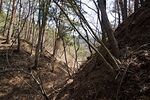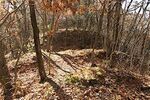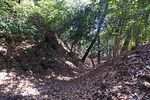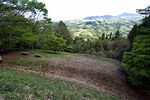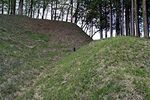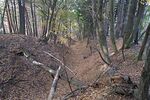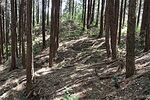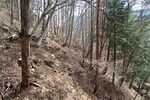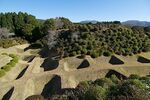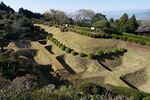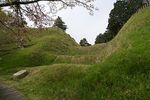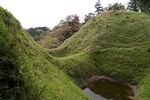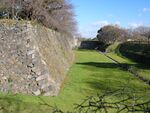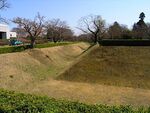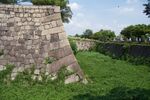Loading map...
{"format":"leaflet","minzoom":false,"maxzoom":false,"limit":500,"offset":0,"link":"all","sort":[""],"order":[],"headers":"show","mainlabel":"","intro":"","outro":"","searchlabel":"... further results","default":"","import-annotation":false,"width":"auto","height":"600px","centre":false,"title":"","label":"","icon":"Darkgreen18.png","lines":[],"polygons":[],"circles":[],"rectangles":[],"copycoords":false,"static":false,"zoom":false,"defzoom":14,"layers":["Esri.WorldTopoMap"],"image layers":[],"overlays":[],"resizable":false,"fullscreen":false,"scrollwheelzoom":true,"cluster":false,"clustermaxzoom":20,"clusterzoomonclick":true,"clustermaxradius":80,"clusterspiderfy":true,"geojson":"","clicktarget":"","showtitle":true,"hidenamespace":true,"template":"","userparam":"","activeicon":"","pagelabel":false,"ajaxcoordproperty":"","ajaxquery":"","locations":[{"text":"\u003Cb\u003E\u003Ca href=\"/view/Aiki_Castle_(Minochi)\" title=\"Aiki Castle (Minochi)\"\u003EAiki Castle (Minochi)\u003C/a\u003E\u003C/b\u003E","title":"Aiki Castle (Minochi)","link":"","lat":36.66515,"lon":138.20489,"icon":"../images/d/db/Darkgreen18.png"},{"text":"\u003Cb\u003E\u003Ca href=\"/view/Akagi_Kita_Castle\" title=\"Akagi Kita Castle\"\u003EAkagi Kita Castle\u003C/a\u003E\u003C/b\u003E","title":"Akagi Kita Castle","link":"","lat":36.16266,"lon":137.97342,"icon":"../images/d/db/Darkgreen18.png"},{"text":"\u003Cb\u003E\u003Ca href=\"/view/Akagi_Minami_Castle\" title=\"Akagi Minami Castle\"\u003EAkagi Minami Castle\u003C/a\u003E\u003C/b\u003E","title":"Akagi Minami Castle","link":"","lat":36.15552,"lon":137.97314,"icon":"../images/d/db/Darkgreen18.png"},{"text":"\u003Cb\u003E\u003Ca href=\"/view/Akaiwa_Castle\" title=\"Akaiwa Castle\"\u003EAkaiwa Castle\u003C/a\u003E\u003C/b\u003E","title":"Akaiwa Castle","link":"","lat":34.76677,"lon":137.44601,"icon":"../images/d/db/Darkgreen18.png"},{"text":"\u003Cb\u003E\u003Ca href=\"/view/Akasu_Castle_(Ina)\" title=\"Akasu Castle (Ina)\"\u003EAkasu Castle (Ina)\u003C/a\u003E\u003C/b\u003E","title":"Akasu Castle (Ina)","link":"","lat":35.72544,"lon":137.95992,"icon":"../images/d/db/Darkgreen18.png"},{"text":"\u003Cb\u003E\u003Ca href=\"/view/Akatsuka_Castle\" title=\"Akatsuka Castle\"\u003EAkatsuka Castle\u003C/a\u003E\u003C/b\u003E","title":"Akatsuka Castle","link":"","lat":35.78455,"lon":139.64351,"icon":"../images/d/db/Darkgreen18.png"},{"text":"\u003Cb\u003E\u003Ca href=\"/view/Akayama_Jin%27ya\" title=\"Akayama Jin\u0026#039;ya\"\u003EAkayama Jin'ya\u003C/a\u003E\u003C/b\u003E","title":"Akayama Jin'ya","link":"","lat":35.85087,"lon":139.74669,"icon":"../images/d/db/Darkgreen18.png"},{"text":"\u003Cb\u003E\u003Ca href=\"/view/Akechi_Castle\" title=\"Akechi Castle\"\u003EAkechi Castle\u003C/a\u003E\u003C/b\u003E","title":"Akechi Castle","link":"","lat":35.30359,"lon":137.39445,"icon":"../images/d/db/Darkgreen18.png"},{"text":"\u003Cb\u003E\u003Ca href=\"/view/Akechi_Osayama_Castle\" title=\"Akechi Osayama Castle\"\u003EAkechi Osayama Castle\u003C/a\u003E\u003C/b\u003E","title":"Akechi Osayama Castle","link":"","lat":35.42205,"lon":137.08468,"icon":"../images/d/db/Darkgreen18.png"},{"text":"\u003Cb\u003E\u003Ca href=\"/view/Akiba_Fort_(Azumi)\" title=\"Akiba Fort (Azumi)\"\u003EAkiba Fort (Azumi)\u003C/a\u003E\u003C/b\u003E","title":"Akiba Fort (Azumi)","link":"","lat":36.65417,"lon":137.84308,"icon":"../images/d/db/Darkgreen18.png"},{"text":"\u003Cb\u003E\u003Ca href=\"/view/Akiyoshi_Fort\" title=\"Akiyoshi Fort\"\u003EAkiyoshi Fort\u003C/a\u003E\u003C/b\u003E","title":"Akiyoshi Fort","link":"","lat":36.3648,"lon":138.00819,"icon":"../images/d/db/Darkgreen18.png"},{"text":"\u003Cb\u003E\u003Ca href=\"/view/Akizuki_Castle\" title=\"Akizuki Castle\"\u003EAkizuki Castle\u003C/a\u003E\u003C/b\u003E","title":"Akizuki Castle","link":"","lat":33.46607,"lon":130.69543,"icon":"../images/d/db/Darkgreen18.png"},{"text":"\u003Cb\u003E\u003Ca href=\"/view/Akutagawasan_Castle\" title=\"Akutagawasan Castle\"\u003EAkutagawasan Castle\u003C/a\u003E\u003C/b\u003E","title":"Akutagawasan Castle","link":"","lat":34.88097,"lon":135.58831,"icon":"../images/d/db/Darkgreen18.png"},{"text":"\u003Cb\u003E\u003Ca href=\"/view/Amabiki_Castle\" title=\"Amabiki Castle\"\u003EAmabiki Castle\u003C/a\u003E\u003C/b\u003E","title":"Amabiki Castle","link":"","lat":36.64831,"lon":138.34699,"icon":"../images/d/db/Darkgreen18.png"},{"text":"\u003Cb\u003E\u003Ca href=\"/view/Amagata_Castle\" title=\"Amagata Castle\"\u003EAmagata Castle\u003C/a\u003E\u003C/b\u003E","title":"Amagata Castle","link":"","lat":34.84768,"lon":137.9496,"icon":"../images/d/db/Darkgreen18.png"},{"text":"\u003Cb\u003E\u003Ca href=\"/view/Amanari_Castle\" title=\"Amanari Castle\"\u003EAmanari Castle\u003C/a\u003E\u003C/b\u003E","title":"Amanari Castle","link":"","lat":35.58719,"lon":138.42136,"icon":"../images/d/db/Darkgreen18.png"},{"text":"\u003Cb\u003E\u003Ca href=\"/view/Ametoya_Castle\" title=\"Ametoya Castle\"\u003EAmetoya Castle\u003C/a\u003E\u003C/b\u003E","title":"Ametoya Castle","link":"","lat":36.36521,"lon":137.98,"icon":"../images/d/db/Darkgreen18.png"},{"text":"\u003Cb\u003E\u003Ca href=\"/view/Amidagamine_Castle_(Yamashiro)\" title=\"Amidagamine Castle (Yamashiro)\"\u003EAmidagamine Castle (Yamashiro)\u003C/a\u003E\u003C/b\u003E","title":"Amidagamine Castle (Yamashiro)","link":"","lat":34.98822,"lon":135.78478,"icon":"../images/d/db/Darkgreen18.png"},{"text":"\u003Cb\u003E\u003Ca href=\"/view/Ansho_Castle\" title=\"Ansho Castle\"\u003EAnsho Castle\u003C/a\u003E\u003C/b\u003E","title":"Ansho Castle","link":"","lat":34.94555,"lon":137.09916,"icon":"../images/d/db/Darkgreen18.png"},{"text":"\u003Cb\u003E\u003Ca href=\"/view/Aoiyama_Castle\" title=\"Aoiyama Castle\"\u003EAoiyama Castle\u003C/a\u003E\u003C/b\u003E","title":"Aoiyama Castle","link":"","lat":35.49361,"lon":135.73204,"icon":"../images/d/db/Darkgreen18.png"},{"text":"\u003Cb\u003E\u003Ca href=\"/view/Aoki_Castle_(Azumi)\" title=\"Aoki Castle (Azumi)\"\u003EAoki Castle (Azumi)\u003C/a\u003E\u003C/b\u003E","title":"Aoki Castle (Azumi)","link":"","lat":36.48358,"lon":137.88329,"icon":"../images/d/db/Darkgreen18.png"},{"text":"\u003Cb\u003E\u003Ca href=\"/view/Aoyagi_Castle\" title=\"Aoyagi Castle\"\u003EAoyagi Castle\u003C/a\u003E\u003C/b\u003E","title":"Aoyagi Castle","link":"","lat":36.43089,"lon":138.03387,"icon":"../images/d/db/Darkgreen18.png"},{"text":"\u003Cb\u003E\u003Ca href=\"/view/Aoyama_Castle\" title=\"Aoyama Castle\"\u003EAoyama Castle\u003C/a\u003E\u003C/b\u003E","title":"Aoyama Castle","link":"","lat":36.03746,"lon":139.26793,"icon":"../images/d/db/Darkgreen18.png"},{"text":"\u003Cb\u003E\u003Ca href=\"/view/Aoyama_Castle_(Nagato)\" title=\"Aoyama Castle (Nagato)\"\u003EAoyama Castle (Nagato)\u003C/a\u003E\u003C/b\u003E","title":"Aoyama Castle (Nagato)","link":"","lat":34.01863,"lon":130.96367,"icon":"../images/d/db/Darkgreen18.png"},{"text":"\u003Cb\u003E\u003Ca href=\"/view/Aoyama_Castle_(Omi)\" title=\"Aoyama Castle (Omi)\"\u003EAoyama Castle (Omi)\u003C/a\u003E\u003C/b\u003E","title":"Aoyama Castle (Omi)","link":"","lat":35.09672,"lon":136.26776,"icon":"../images/d/db/Darkgreen18.png"},{"text":"\u003Cb\u003E\u003Ca href=\"/view/Ara_Castle_(Ina)\" title=\"Ara Castle (Ina)\"\u003EAra Castle (Ina)\u003C/a\u003E\u003C/b\u003E","title":"Ara Castle (Ina)","link":"","lat":35.81878,"lon":137.93876,"icon":"../images/d/db/Darkgreen18.png"},{"text":"\u003Cb\u003E\u003Ca href=\"/view/Ara_Castle_(Murakami_Clan_Fort_Network)\" title=\"Ara Castle (Murakami Clan Fort Network)\"\u003EAra Castle (Murakami Clan Fort Network)\u003C/a\u003E\u003C/b\u003E","title":"Ara Castle (Murakami Clan Fort Network)","link":"","lat":36.42649,"lon":138.25265,"icon":"../images/d/db/Darkgreen18.png"},{"text":"\u003Cb\u003E\u003Ca href=\"/view/Aragaito_Fort\" title=\"Aragaito Fort\"\u003EAragaito Fort\u003C/a\u003E\u003C/b\u003E","title":"Aragaito Fort","link":"","lat":36.21128,"lon":137.84487,"icon":"../images/d/db/Darkgreen18.png"},{"text":"\u003Cb\u003E\u003Ca href=\"/view/Araihara_Castle\" title=\"Araihara Castle\"\u003EAraihara Castle\u003C/a\u003E\u003C/b\u003E","title":"Araihara Castle","link":"","lat":36.67045,"lon":138.36189,"icon":"../images/d/db/Darkgreen18.png"},{"text":"\u003Cb\u003E\u003Ca href=\"/view/Arashi_Castle\" title=\"Arashi Castle\"\u003EArashi Castle\u003C/a\u003E\u003C/b\u003E","title":"Arashi Castle","link":"","lat":36.08807,"lon":137.96875,"icon":"../images/d/db/Darkgreen18.png"},{"text":"\u003Cb\u003E\u003Ca href=\"/view/Aratoshou_Castle\" title=\"Aratoshou Castle\"\u003EAratoshou Castle\u003C/a\u003E\u003C/b\u003E","title":"Aratoshou Castle","link":"","lat":36.47965,"lon":138.13447,"icon":"../images/d/db/Darkgreen18.png"},{"text":"\u003Cb\u003E\u003Ca href=\"/view/Arikoyama_Castle\" title=\"Arikoyama Castle\"\u003EArikoyama Castle\u003C/a\u003E\u003C/b\u003E","title":"Arikoyama Castle","link":"","lat":35.45545,"lon":134.87812,"icon":"../images/d/db/Darkgreen18.png"},{"text":"\u003Cb\u003E\u003Ca href=\"/view/Aruga_Castle\" title=\"Aruga Castle\"\u003EAruga Castle\u003C/a\u003E\u003C/b\u003E","title":"Aruga Castle","link":"","lat":36.01732,"lon":138.08084,"icon":"../images/d/db/Darkgreen18.png"},{"text":"\u003Cb\u003E\u003Ca href=\"/view/Asaba_Castle\" title=\"Asaba Castle\"\u003EAsaba Castle\u003C/a\u003E\u003C/b\u003E","title":"Asaba Castle","link":"","lat":36.24762,"lon":138.94259,"icon":"../images/d/db/Darkgreen18.png"},{"text":"\u003Cb\u003E\u003Ca href=\"/view/Asahi_Castle_(Chikuma)\" title=\"Asahi Castle (Chikuma)\"\u003EAsahi Castle (Chikuma)\u003C/a\u003E\u003C/b\u003E","title":"Asahi Castle (Chikuma)","link":"","lat":36.1388,"lon":137.86029,"icon":"../images/d/db/Darkgreen18.png"},{"text":"\u003Cb\u003E\u003Ca href=\"/view/Asahi_Castle_(Owari)\" title=\"Asahi Castle (Owari)\"\u003EAsahi Castle (Owari)\u003C/a\u003E\u003C/b\u003E","title":"Asahi Castle (Owari)","link":"","lat":35.21926,"lon":137.02857,"icon":"../images/d/db/Darkgreen18.png"},{"text":"\u003Cb\u003E\u003Ca href=\"/view/Asahi_Moated_Settlement\" title=\"Asahi Moated Settlement\"\u003EAsahi Moated Settlement\u003C/a\u003E\u003C/b\u003E","title":"Asahi Moated Settlement","link":"","lat":35.2185,"lon":136.85134,"icon":"../images/d/db/Darkgreen18.png"},{"text":"\u003Cb\u003E\u003Ca href=\"/view/Asahiyama_Castle\" title=\"Asahiyama Castle\"\u003EAsahiyama Castle\u003C/a\u003E\u003C/b\u003E","title":"Asahiyama Castle","link":"","lat":36.65444,"lon":138.16278,"icon":"../images/d/db/Darkgreen18.png"},{"text":"\u003Cb\u003E\u003Ca href=\"/view/Asahiyama_Castle_(Kai)\" title=\"Asahiyama Castle (Kai)\"\u003EAsahiyama Castle (Kai)\u003C/a\u003E\u003C/b\u003E","title":"Asahiyama Castle (Kai)","link":"","lat":35.85261,"lon":138.42724,"icon":"../images/d/db/Darkgreen18.png"},{"text":"\u003Cb\u003E\u003Ca href=\"/view/Asaka_Castle_(Chikuma)\" title=\"Asaka Castle (Chikuma)\"\u003EAsaka Castle (Chikuma)\u003C/a\u003E\u003C/b\u003E","title":"Asaka Castle (Chikuma)","link":"","lat":36.44489,"lon":138.06209,"icon":"../images/d/db/Darkgreen18.png"},{"text":"\u003Cb\u003E\u003Ca href=\"/view/Asakura_Yakata\" title=\"Asakura Yakata\"\u003EAsakura Yakata\u003C/a\u003E\u003C/b\u003E","title":"Asakura Yakata","link":"","lat":35.99946,"lon":136.29593,"icon":"../images/d/db/Darkgreen18.png"},{"text":"\u003Cb\u003E\u003Ca href=\"/view/Ashigara_Castle\" title=\"Ashigara Castle\"\u003EAshigara Castle\u003C/a\u003E\u003C/b\u003E","title":"Ashigara Castle","link":"","lat":35.32088,"lon":139.01183,"icon":"../images/d/db/Darkgreen18.png"},{"text":"\u003Cb\u003E\u003Ca href=\"/view/Ashikaga_Masauji_Yakata\" title=\"Ashikaga Masauji Yakata\"\u003EAshikaga Masauji Yakata\u003C/a\u003E\u003C/b\u003E","title":"Ashikaga Masauji Yakata","link":"","lat":36.07376,"lon":139.66851,"icon":"../images/d/db/Darkgreen18.png"},{"text":"\u003Cb\u003E\u003Ca href=\"/view/Ashinoya_Jin%27ya\" title=\"Ashinoya Jin\u0026#039;ya\"\u003EAshinoya Jin'ya\u003C/a\u003E\u003C/b\u003E","title":"Ashinoya Jin'ya","link":"","lat":34.85829,"lon":137.16873,"icon":"../images/d/db/Darkgreen18.png"},{"text":"\u003Cb\u003E\u003Ca href=\"/view/Asonuma_Castle\" title=\"Asonuma Castle\"\u003EAsonuma Castle\u003C/a\u003E\u003C/b\u003E","title":"Asonuma Castle","link":"","lat":36.31094,"lon":139.58723,"icon":"../images/d/db/Darkgreen18.png"},{"text":"\u003Cb\u003E\u003Ca href=\"/view/Asuke_Castle\" title=\"Asuke Castle\"\u003EAsuke Castle\u003C/a\u003E\u003C/b\u003E","title":"Asuke Castle","link":"","lat":35.13447,"lon":137.32534,"icon":"../images/d/db/Darkgreen18.png"},{"text":"\u003Cb\u003E\u003Ca href=\"/view/Awaji_Castle_(Chikuma)\" title=\"Awaji Castle (Chikuma)\"\u003EAwaji Castle (Chikuma)\u003C/a\u003E\u003C/b\u003E","title":"Awaji Castle (Chikuma)","link":"","lat":36.19572,"lon":137.84964,"icon":"../images/d/db/Darkgreen18.png"},{"text":"\u003Cb\u003E\u003Ca href=\"/view/Awaya_Yakata\" title=\"Awaya Yakata\"\u003EAwaya Yakata\u003C/a\u003E\u003C/b\u003E","title":"Awaya Yakata","link":"","lat":35.6118,"lon":135.96265,"icon":"../images/d/db/Darkgreen18.png"},{"text":"\u003Cb\u003E\u003Ca href=\"/view/Awazawa_Castle_(Suwa)\" title=\"Awazawa Castle (Suwa)\"\u003EAwazawa Castle (Suwa)\u003C/a\u003E\u003C/b\u003E","title":"Awazawa Castle (Suwa)","link":"","lat":35.99796,"lon":138.17575,"icon":"../images/d/db/Darkgreen18.png"},{"text":"\u003Cb\u003E\u003Ca href=\"/view/Ayukawa_Castle_(Koka)\" title=\"Ayukawa Castle (Koka)\"\u003EAyukawa Castle (Koka)\u003C/a\u003E\u003C/b\u003E","title":"Ayukawa Castle (Koka)","link":"","lat":34.95723,"lon":136.34561,"icon":"../images/d/db/Darkgreen18.png"},{"text":"\u003Cb\u003E\u003Ca href=\"/view/Azuchi_Castle\" title=\"Azuchi Castle\"\u003EAzuchi Castle\u003C/a\u003E\u003C/b\u003E","title":"Azuchi Castle","link":"","lat":35.15593,"lon":136.13928,"icon":"../images/d/db/Darkgreen18.png"},{"text":"\u003Cb\u003E\u003Ca href=\"/view/Baba_Yashiki\" title=\"Baba Yashiki\"\u003EBaba Yashiki\u003C/a\u003E\u003C/b\u003E","title":"Baba Yashiki","link":"","lat":36.16734,"lon":137.98551,"icon":"../images/d/db/Darkgreen18.png"},{"text":"\u003Cb\u003E\u003Ca href=\"/view/Banba_Castle\" title=\"Banba Castle\"\u003EBanba Castle\u003C/a\u003E\u003C/b\u003E","title":"Banba Castle","link":"","lat":35.30523,"lon":136.3105,"icon":"../images/d/db/Darkgreen18.png"},{"text":"\u003Cb\u003E\u003Ca href=\"/view/Besshoyama_Fort\" title=\"Besshoyama Fort\"\u003EBesshoyama Fort\u003C/a\u003E\u003C/b\u003E","title":"Besshoyama Fort","link":"","lat":35.56369,"lon":136.18172,"icon":"../images/d/db/Darkgreen18.png"},{"text":"\u003Cb\u003E\u003Ca href=\"/view/Binmanji_Castle\" title=\"Binmanji Castle\"\u003EBinmanji Castle\u003C/a\u003E\u003C/b\u003E","title":"Binmanji Castle","link":"","lat":35.21938,"lon":136.28291,"icon":"../images/d/db/Darkgreen18.png"},{"text":"\u003Cb\u003E\u003Ca href=\"/view/Bitchu_Matsuyama_Castle\" title=\"Bitchu Matsuyama Castle\"\u003EBitchu Matsuyama Castle\u003C/a\u003E\u003C/b\u003E","title":"Bitchu Matsuyama Castle","link":"","lat":34.80891,"lon":133.62219,"icon":"../images/d/db/Darkgreen18.png"},{"text":"\u003Cb\u003E\u003Ca href=\"/view/Bitchu_Takamatsu_Castle\" title=\"Bitchu Takamatsu Castle\"\u003EBitchu Takamatsu Castle\u003C/a\u003E\u003C/b\u003E","title":"Bitchu Takamatsu Castle","link":"","lat":34.69281,"lon":133.82206,"icon":"../images/d/db/Darkgreen18.png"},{"text":"\u003Cb\u003E\u003Ca href=\"/view/Bodaiyama_Castle\" title=\"Bodaiyama Castle\"\u003EBodaiyama Castle\u003C/a\u003E\u003C/b\u003E","title":"Bodaiyama Castle","link":"","lat":35.39294,"lon":136.48322,"icon":"../images/d/db/Darkgreen18.png"},{"text":"\u003Cb\u003E\u003Ca href=\"/view/Bue_Yakata_(Totomi)\" title=\"Bue Yakata (Totomi)\"\u003EBue Yakata (Totomi)\u003C/a\u003E\u003C/b\u003E","title":"Bue Yakata (Totomi)","link":"","lat":34.72565,"lon":138.10891,"icon":"../images/d/db/Darkgreen18.png"},{"text":"\u003Cb\u003E\u003Ca href=\"/view/Chausudate\" title=\"Chausudate\"\u003EChausudate\u003C/a\u003E\u003C/b\u003E","title":"Chausudate","link":"","lat":40.16746,"lon":140.10799,"icon":"../images/d/db/Darkgreen18.png"},{"text":"\u003Cb\u003E\u003Ca href=\"/view/Chausuyama_Castle_(Nukata)\" title=\"Chausuyama Castle (Nukata)\"\u003EChausuyama Castle (Nukata)\u003C/a\u003E\u003C/b\u003E","title":"Chausuyama Castle (Nukata)","link":"","lat":34.83906,"lon":137.11792,"icon":"../images/d/db/Darkgreen18.png"},{"text":"\u003Cb\u003E\u003Ca href=\"/view/Chausuyama_Castle_(Shinano)\" title=\"Chausuyama Castle (Shinano)\"\u003EChausuyama Castle (Shinano)\u003C/a\u003E\u003C/b\u003E","title":"Chausuyama Castle (Shinano)","link":"","lat":36.26686,"lon":137.98729,"icon":"../images/d/db/Darkgreen18.png"},{"text":"\u003Cb\u003E\u003Ca href=\"/view/Chausuyama_Fort\" title=\"Chausuyama Fort\"\u003EChausuyama Fort\u003C/a\u003E\u003C/b\u003E","title":"Chausuyama Fort","link":"","lat":35.55708,"lon":136.1919,"icon":"../images/d/db/Darkgreen18.png"},{"text":"\u003Cb\u003E\u003Ca href=\"/view/Chigasaki_Castle\" title=\"Chigasaki Castle\"\u003EChigasaki Castle\u003C/a\u003E\u003C/b\u003E","title":"Chigasaki Castle","link":"","lat":35.54474,"lon":139.5791,"icon":"../images/d/db/Darkgreen18.png"},{"text":"\u003Cb\u003E\u003Ca href=\"/view/Chihaya_Castle\" title=\"Chihaya Castle\"\u003EChihaya Castle\u003C/a\u003E\u003C/b\u003E","title":"Chihaya Castle","link":"","lat":34.4162,"lon":135.65294,"icon":"../images/d/db/Darkgreen18.png"},{"text":"\u003Cb\u003E\u003Ca href=\"/view/Chikaoka_Castle\" title=\"Chikaoka Castle\"\u003EChikaoka Castle\u003C/a\u003E\u003C/b\u003E","title":"Chikaoka Castle","link":"","lat":35.12683,"lon":137.29722,"icon":"../images/d/db/Darkgreen18.png"},{"text":"\u003Cb\u003E\u003Ca href=\"/view/Chikatou_Fort\" title=\"Chikatou Fort\"\u003EChikatou Fort\u003C/a\u003E\u003C/b\u003E","title":"Chikatou Fort","link":"","lat":36.22084,"lon":137.99342,"icon":"../images/d/db/Darkgreen18.png"},{"text":"\u003Cb\u003E\u003Ca href=\"/view/Chikusa_Castle\" title=\"Chikusa Castle\"\u003EChikusa Castle\u003C/a\u003E\u003C/b\u003E","title":"Chikusa Castle","link":"","lat":35.03277,"lon":136.48592,"icon":"../images/d/db/Darkgreen18.png"},{"text":"\u003Cb\u003E\u003Ca href=\"/view/Chouja_Yashiki_(Totomi)\" title=\"Chouja Yashiki (Totomi)\"\u003EChouja Yashiki (Totomi)\u003C/a\u003E\u003C/b\u003E","title":"Chouja Yashiki (Totomi)","link":"","lat":34.77842,"lon":137.84142,"icon":"../images/d/db/Darkgreen18.png"},{"text":"\u003Cb\u003E\u003Ca href=\"/view/Choujayama_Castle\" title=\"Choujayama Castle\"\u003EChoujayama Castle\u003C/a\u003E\u003C/b\u003E","title":"Choujayama Castle","link":"","lat":36.41235,"lon":140.4336,"icon":"../images/d/db/Darkgreen18.png"},{"text":"\u003Cb\u003E\u003Ca href=\"/view/Choujayashiki_Yakata\" title=\"Choujayashiki Yakata\"\u003EChoujayashiki Yakata\u003C/a\u003E\u003C/b\u003E","title":"Choujayashiki Yakata","link":"","lat":36.16485,"lon":137.94641,"icon":"../images/d/db/Darkgreen18.png"},{"text":"\u003Cb\u003E\u003Ca href=\"/view/Daikan_Yashiki\" title=\"Daikan Yashiki\"\u003EDaikan Yashiki\u003C/a\u003E\u003C/b\u003E","title":"Daikan Yashiki","link":"","lat":35.0372,"lon":137.31663,"icon":"../images/d/db/Darkgreen18.png"},{"text":"\u003Cb\u003E\u003Ca href=\"/view/Daikan%27yashiki_Castle\" title=\"Daikan\u0026#039;yashiki Castle\"\u003EDaikan'yashiki Castle\u003C/a\u003E\u003C/b\u003E","title":"Daikan'yashiki Castle","link":"","lat":35.03896,"lon":137.31752,"icon":"../images/d/db/Darkgreen18.png"},{"text":"\u003Cb\u003E\u003Ca href=\"/view/Dainenji_Yakata\" title=\"Dainenji Yakata\"\u003EDainenji Yakata\u003C/a\u003E\u003C/b\u003E","title":"Dainenji Yakata","link":"","lat":36.50527,"lon":137.85717,"icon":"../images/d/db/Darkgreen18.png"},{"text":"\u003Cb\u003E\u003Ca href=\"/view/Daita_Castle\" title=\"Daita Castle\"\u003EDaita Castle\u003C/a\u003E\u003C/b\u003E","title":"Daita Castle","link":"","lat":35.06053,"lon":137.24228,"icon":"../images/d/db/Darkgreen18.png"},{"text":"\u003Cb\u003E\u003Ca href=\"/view/Damine_Castle\" title=\"Damine Castle\"\u003EDamine Castle\u003C/a\u003E\u003C/b\u003E","title":"Damine Castle","link":"","lat":35.05494,"lon":137.53458,"icon":"../images/d/db/Darkgreen18.png"},{"text":"\u003Cb\u003E\u003Ca href=\"/view/Deura_Castle\" title=\"Deura Castle\"\u003EDeura Castle\u003C/a\u003E\u003C/b\u003E","title":"Deura Castle","link":"","lat":36.45297,"lon":138.15385,"icon":"../images/d/db/Darkgreen18.png"},{"text":"\u003Cb\u003E\u003Ca href=\"/view/Dodo_Fort\" title=\"Dodo Fort\"\u003EDodo Fort\u003C/a\u003E\u003C/b\u003E","title":"Dodo Fort","link":"","lat":34.96334,"lon":137.25094,"icon":"../images/d/db/Darkgreen18.png"},{"text":"\u003Cb\u003E\u003Ca href=\"/view/Dogiyama_Fort\" title=\"Dogiyama Fort\"\u003EDogiyama Fort\u003C/a\u003E\u003C/b\u003E","title":"Dogiyama Fort","link":"","lat":35.54415,"lon":136.19834,"icon":"../images/d/db/Darkgreen18.png"},{"text":"\u003Cb\u003E\u003Ca href=\"/view/Dokyou_Castle\" title=\"Dokyou Castle\"\u003EDokyou Castle\u003C/a\u003E\u003C/b\u003E","title":"Dokyou Castle","link":"","lat":36.69473,"lon":138.22675,"icon":"../images/d/db/Darkgreen18.png"},{"text":"\u003Cb\u003E\u003Ca href=\"/view/Dota_Castle_(Mino)\" title=\"Dota Castle (Mino)\"\u003EDota Castle (Mino)\u003C/a\u003E\u003C/b\u003E","title":"Dota Castle (Mino)","link":"","lat":35.41738,"lon":137.00807,"icon":"../images/d/db/Darkgreen18.png"},{"text":"\u003Cb\u003E\u003Ca href=\"/view/Dousawa_Fort\" title=\"Dousawa Fort\"\u003EDousawa Fort\u003C/a\u003E\u003C/b\u003E","title":"Dousawa Fort","link":"","lat":36.69399,"lon":138.21724,"icon":"../images/d/db/Darkgreen18.png"},{"text":"\u003Cb\u003E\u003Ca href=\"/view/Eboshigata_Castle\" title=\"Eboshigata Castle\"\u003EEboshigata Castle\u003C/a\u003E\u003C/b\u003E","title":"Eboshigata Castle","link":"","lat":34.44464,"lon":135.56465,"icon":"../images/d/db/Darkgreen18.png"},{"text":"\u003Cb\u003E\u003Ca href=\"/view/Echizen_Ohno_Castle\" title=\"Echizen Ohno Castle\"\u003EEchizen Ohno Castle\u003C/a\u003E\u003C/b\u003E","title":"Echizen Ohno Castle","link":"","lat":35.98661,"lon":136.4831,"icon":"../images/d/db/Darkgreen18.png"},{"text":"\u003Cb\u003E\u003Ca href=\"/view/Egawa_Fort\" title=\"Egawa Fort\"\u003EEgawa Fort\u003C/a\u003E\u003C/b\u003E","title":"Egawa Fort","link":"","lat":35.0535,"lon":138.95915,"icon":"../images/d/db/Darkgreen18.png"},{"text":"\u003Cb\u003E\u003Ca href=\"/view/Ema_Yakata\" title=\"Ema Yakata\"\u003EEma Yakata\u003C/a\u003E\u003C/b\u003E","title":"Ema Yakata","link":"","lat":36.32622,"lon":137.30951,"icon":"../images/d/db/Darkgreen18.png"},{"text":"\u003Cb\u003E\u003Ca href=\"/view/Enryakuji_Higashitani_Fort\" title=\"Enryakuji Higashitani Fort\"\u003EEnryakuji Higashitani Fort\u003C/a\u003E\u003C/b\u003E","title":"Enryakuji Higashitani Fort","link":"","lat":35.07433,"lon":135.8358,"icon":"../images/d/db/Darkgreen18.png"},{"text":"\u003Cb\u003E\u003Ca href=\"/view/Enryakuji_Kitatani_Fort\" title=\"Enryakuji Kitatani Fort\"\u003EEnryakuji Kitatani Fort\u003C/a\u003E\u003C/b\u003E","title":"Enryakuji Kitatani Fort","link":"","lat":35.07238,"lon":135.83972,"icon":"../images/d/db/Darkgreen18.png"},{"text":"\u003Cb\u003E\u003Ca href=\"/view/Enryakuji_Nishitani_Fort\" title=\"Enryakuji Nishitani Fort\"\u003EEnryakuji Nishitani Fort\u003C/a\u003E\u003C/b\u003E","title":"Enryakuji Nishitani Fort","link":"","lat":35.07602,"lon":135.83404,"icon":"../images/d/db/Darkgreen18.png"},{"text":"\u003Cb\u003E\u003Ca href=\"/view/Fubukikaito_Castle_(Ina)\" title=\"Fubukikaito Castle (Ina)\"\u003EFubukikaito Castle (Ina)\u003C/a\u003E\u003C/b\u003E","title":"Fubukikaito Castle (Ina)","link":"","lat":35.81649,"lon":137.93961,"icon":"../images/d/db/Darkgreen18.png"},{"text":"\u003Cb\u003E\u003Ca href=\"/view/Fuchu_Castle_(Hitachi)\" title=\"Fuchu Castle (Hitachi)\"\u003EFuchu Castle (Hitachi)\u003C/a\u003E\u003C/b\u003E","title":"Fuchu Castle (Hitachi)","link":"","lat":36.19029,"lon":140.27019,"icon":"../images/d/db/Darkgreen18.png"},{"text":"\u003Cb\u003E\u003Ca href=\"/view/Fujihashi_Castle_(Tokyo)\" title=\"Fujihashi Castle (Tokyo)\"\u003EFujihashi Castle (Tokyo)\u003C/a\u003E\u003C/b\u003E","title":"Fujihashi Castle (Tokyo)","link":"","lat":35.80393,"lon":139.30046,"icon":"../images/d/db/Darkgreen18.png"},{"text":"\u003Cb\u003E\u003Ca href=\"/view/Fujita_Castle\" title=\"Fujita Castle\"\u003EFujita Castle\u003C/a\u003E\u003C/b\u003E","title":"Fujita Castle","link":"","lat":37.18184,"lon":140.42305,"icon":"../images/d/db/Darkgreen18.png"},{"text":"\u003Cb\u003E\u003Ca href=\"/view/Fukakusa_Yakata\" title=\"Fukakusa Yakata\"\u003EFukakusa Yakata\u003C/a\u003E\u003C/b\u003E","title":"Fukakusa Yakata","link":"","lat":35.84646,"lon":138.38364,"icon":"../images/d/db/Darkgreen18.png"},{"text":"\u003Cb\u003E\u003Ca href=\"/view/Fukayama_Castle_(Suruga)\" title=\"Fukayama Castle (Suruga)\"\u003EFukayama Castle (Suruga)\u003C/a\u003E\u003C/b\u003E","title":"Fukayama Castle (Suruga)","link":"","lat":35.25001,"lon":138.84058,"icon":"../images/d/db/Darkgreen18.png"},{"text":"\u003Cb\u003E\u003Ca href=\"/view/Fukazawa_Castle\" title=\"Fukazawa Castle\"\u003EFukazawa Castle\u003C/a\u003E\u003C/b\u003E","title":"Fukazawa Castle","link":"","lat":35.32499,"lon":138.95666,"icon":"../images/d/db/Darkgreen18.png"},{"text":"\u003Cb\u003E\u003Ca href=\"/view/Fukigabora_Castle\" title=\"Fukigabora Castle\"\u003EFukigabora Castle\u003C/a\u003E\u003C/b\u003E","title":"Fukigabora Castle","link":"","lat":35.40003,"lon":137.07815,"icon":"../images/d/db/Darkgreen18.png"},{"text":"\u003Cb\u003E\u003Ca href=\"/view/Fukui_Castle_(Shinano)\" title=\"Fukui Castle (Shinano)\"\u003EFukui Castle (Shinano)\u003C/a\u003E\u003C/b\u003E","title":"Fukui Castle (Shinano)","link":"","lat":36.66392,"lon":138.39509,"icon":"../images/d/db/Darkgreen18.png"},{"text":"\u003Cb\u003E\u003Ca href=\"/view/Fukuju_Fort_(Odani_Castle)\" title=\"Fukuju Fort (Odani Castle)\"\u003EFukuju Fort (Odani Castle)\u003C/a\u003E\u003C/b\u003E","title":"Fukuju Fort (Odani Castle)","link":"","lat":35.46085,"lon":136.26913,"icon":"../images/d/db/Darkgreen18.png"},{"text":"\u003Cb\u003E\u003Ca href=\"/view/Fukushima_Castle_(Kiso)\" title=\"Fukushima Castle (Kiso)\"\u003EFukushima Castle (Kiso)\u003C/a\u003E\u003C/b\u003E","title":"Fukushima Castle (Kiso)","link":"","lat":35.85485,"lon":137.69432,"icon":"../images/d/db/Darkgreen18.png"},{"text":"\u003Cb\u003E\u003Ca href=\"/view/Fukuyo_Castle\" title=\"Fukuyo Castle\"\u003EFukuyo Castle\u003C/a\u003E\u003C/b\u003E","title":"Fukuyo Castle","link":"","lat":35.89595,"lon":138.0003,"icon":"../images/d/db/Darkgreen18.png"},{"text":"\u003Cb\u003E\u003Ca href=\"/view/Fumimichi_Castle\" title=\"Fumimichi Castle\"\u003EFumimichi Castle\u003C/a\u003E\u003C/b\u003E","title":"Fumimichi Castle","link":"","lat":36.69048,"lon":138.01484,"icon":"../images/d/db/Darkgreen18.png"},{"text":"\u003Cb\u003E\u003Ca href=\"/view/Funagatayama_Castle\" title=\"Funagatayama Castle\"\u003EFunagatayama Castle\u003C/a\u003E\u003C/b\u003E","title":"Funagatayama Castle","link":"","lat":34.74524,"lon":137.46773,"icon":"../images/d/db/Darkgreen18.png"},{"text":"\u003Cb\u003E\u003Ca href=\"/view/Funaoka_Castle\" title=\"Funaoka Castle\"\u003EFunaoka Castle\u003C/a\u003E\u003C/b\u003E","title":"Funaoka Castle","link":"","lat":38.05508,"lon":140.75873,"icon":"../images/d/db/Darkgreen18.png"},{"text":"\u003Cb\u003E\u003Ca href=\"/view/Funaokayama_Castle\" title=\"Funaokayama Castle\"\u003EFunaokayama Castle\u003C/a\u003E\u003C/b\u003E","title":"Funaokayama Castle","link":"","lat":35.03937,"lon":135.74204,"icon":"../images/d/db/Darkgreen18.png"},{"text":"\u003Cb\u003E\u003Ca href=\"/view/Funayama_Castle\" title=\"Funayama Castle\"\u003EFunayama Castle\u003C/a\u003E\u003C/b\u003E","title":"Funayama Castle","link":"","lat":34.67347,"lon":132.69738,"icon":"../images/d/db/Darkgreen18.png"},{"text":"\u003Cb\u003E\u003Ca href=\"/view/Furujiro_Fort\" title=\"Furujiro Fort\"\u003EFurujiro Fort\u003C/a\u003E\u003C/b\u003E","title":"Furujiro Fort","link":"","lat":35.67242,"lon":138.625,"icon":"../images/d/db/Darkgreen18.png"},{"text":"\u003Cb\u003E\u003Ca href=\"/view/Furujouyama_Castle_(Hanishina)\" title=\"Furujouyama Castle (Hanishina)\"\u003EFurujouyama Castle (Hanishina)\u003C/a\u003E\u003C/b\u003E","title":"Furujouyama Castle (Hanishina)","link":"","lat":36.59659,"lon":138.2315,"icon":"../images/d/db/Darkgreen18.png"},{"text":"\u003Cb\u003E\u003Ca href=\"/view/Furumiya_Castle\" title=\"Furumiya Castle\"\u003EFurumiya Castle\u003C/a\u003E\u003C/b\u003E","title":"Furumiya Castle","link":"","lat":34.97263,"lon":137.4278,"icon":"../images/d/db/Darkgreen18.png"},{"text":"\u003Cb\u003E\u003Ca href=\"/view/Furumiya_Castle_(Kai)\" title=\"Furumiya Castle (Kai)\"\u003EFurumiya Castle (Kai)\u003C/a\u003E\u003C/b\u003E","title":"Furumiya Castle (Kai)","link":"","lat":35.85163,"lon":138.44484,"icon":"../images/d/db/Darkgreen18.png"},{"text":"\u003Cb\u003E\u003Ca href=\"/view/Furuwatari_Castle\" title=\"Furuwatari Castle\"\u003EFuruwatari Castle\u003C/a\u003E\u003C/b\u003E","title":"Furuwatari Castle","link":"","lat":35.15184,"lon":136.90094,"icon":"../images/d/db/Darkgreen18.png"},{"text":"\u003Cb\u003E\u003Ca href=\"/view/Fusumada_Castle\" title=\"Fusumada Castle\"\u003EFusumada Castle\u003C/a\u003E\u003C/b\u003E","title":"Fusumada Castle","link":"","lat":35.56111,"lon":139.15756,"icon":"../images/d/db/Darkgreen18.png"},{"text":"\u003Cb\u003E\u003Ca href=\"/view/Futamata_Castle\" title=\"Futamata Castle\"\u003EFutamata Castle\u003C/a\u003E\u003C/b\u003E","title":"Futamata Castle","link":"","lat":34.86212,"lon":137.80941,"icon":"../images/d/db/Darkgreen18.png"},{"text":"\u003Cb\u003E\u003Ca href=\"/view/Futatsugi_Castle_(Azumi)\" title=\"Futatsugi Castle (Azumi)\"\u003EFutatsugi Castle (Azumi)\u003C/a\u003E\u003C/b\u003E","title":"Futatsugi Castle (Azumi)","link":"","lat":36.25972,"lon":137.8862,"icon":"../images/d/db/Darkgreen18.png"},{"text":"\u003Cb\u003E\u003Ca href=\"/view/Futoge_Castle\" title=\"Futoge Castle\"\u003EFutoge Castle\u003C/a\u003E\u003C/b\u003E","title":"Futoge Castle","link":"","lat":36.35728,"lon":136.60102,"icon":"../images/d/db/Darkgreen18.png"},{"text":"\u003Cb\u003E\u003Ca href=\"/view/Futoh%27yama_Castle\" title=\"Futoh\u0026#039;yama Castle\"\u003EFutoh'yama Castle\u003C/a\u003E\u003C/b\u003E","title":"Futoh'yama Castle","link":"","lat":35.3147,"lon":136.29874,"icon":"../images/d/db/Darkgreen18.png"},{"text":"\u003Cb\u003E\u003Ca href=\"/view/Futsukamachi_Castle\" title=\"Futsukamachi Castle\"\u003EFutsukamachi Castle\u003C/a\u003E\u003C/b\u003E","title":"Futsukamachi Castle","link":"","lat":35.89469,"lon":136.84789,"icon":"../images/d/db/Darkgreen18.png"},{"text":"\u003Cb\u003E\u003Ca href=\"/view/Ganjaku_Castle\" title=\"Ganjaku Castle\"\u003EGanjaku Castle\u003C/a\u003E\u003C/b\u003E","title":"Ganjaku Castle","link":"","lat":33.57136,"lon":130.86415,"icon":"../images/d/db/Darkgreen18.png"},{"text":"\u003Cb\u003E\u003Ca href=\"/view/Ganryakuji_Castle\" title=\"Ganryakuji Castle\"\u003EGanryakuji Castle\u003C/a\u003E\u003C/b\u003E","title":"Ganryakuji Castle","link":"","lat":34.86559,"lon":137.28693,"icon":"../images/d/db/Darkgreen18.png"},{"text":"\u003Cb\u003E\u003Ca href=\"/view/Gassan_Toda_Castle\" title=\"Gassan Toda Castle\"\u003EGassan Toda Castle\u003C/a\u003E\u003C/b\u003E","title":"Gassan Toda Castle","link":"","lat":35.3608,"lon":133.18543,"icon":"../images/d/db/Darkgreen18.png"},{"text":"\u003Cb\u003E\u003Ca href=\"/view/Genbao_Castle\" title=\"Genbao Castle\"\u003EGenbao Castle\u003C/a\u003E\u003C/b\u003E","title":"Genbao Castle","link":"","lat":35.59783,"lon":136.17662,"icon":"../images/d/db/Darkgreen18.png"},{"text":"\u003Cb\u003E\u003Ca href=\"/view/Gentairi_Castle\" title=\"Gentairi Castle\"\u003EGentairi Castle\u003C/a\u003E\u003C/b\u003E","title":"Gentairi Castle","link":"","lat":36.60925,"lon":138.32806,"icon":"../images/d/db/Darkgreen18.png"},{"text":"\u003Cb\u003E\u003Ca href=\"/view/Gifu_Castle\" title=\"Gifu Castle\"\u003EGifu Castle\u003C/a\u003E\u003C/b\u003E","title":"Gifu Castle","link":"","lat":35.43391,"lon":136.7819,"icon":"../images/d/db/Darkgreen18.png"},{"text":"\u003Cb\u003E\u003Ca href=\"/view/Gion_Castle\" title=\"Gion Castle\"\u003EGion Castle\u003C/a\u003E\u003C/b\u003E","title":"Gion Castle","link":"","lat":36.31981,"lon":139.80005,"icon":"../images/d/db/Darkgreen18.png"},{"text":"\u003Cb\u003E\u003Ca href=\"/view/Gobara_Castle\" title=\"Gobara Castle\"\u003EGobara Castle\u003C/a\u003E\u003C/b\u003E","title":"Gobara Castle","link":"","lat":36.5526,"lon":138.79976,"icon":"../images/d/db/Darkgreen18.png"},{"text":"\u003Cb\u003E\u003Ca href=\"/view/Goi_Castle_(Mikawa)\" title=\"Goi Castle (Mikawa)\"\u003EGoi Castle (Mikawa)\u003C/a\u003E\u003C/b\u003E","title":"Goi Castle (Mikawa)","link":"","lat":34.83845,"lon":137.24463,"icon":"../images/d/db/Darkgreen18.png"},{"text":"\u003Cb\u003E\u003Ca href=\"/view/Gokan_Castle\" title=\"Gokan Castle\"\u003EGokan Castle\u003C/a\u003E\u003C/b\u003E","title":"Gokan Castle","link":"","lat":36.3296,"lon":138.84164,"icon":"../images/d/db/Darkgreen18.png"},{"text":"\u003Cb\u003E\u003Ca href=\"/view/Gongen_Yakata\" title=\"Gongen Yakata\"\u003EGongen Yakata\u003C/a\u003E\u003C/b\u003E","title":"Gongen Yakata","link":"","lat":36.13745,"lon":137.97856,"icon":"../images/d/db/Darkgreen18.png"},{"text":"\u003Cb\u003E\u003Ca href=\"/view/Gongen%27yama_Castle_(Mino)\" title=\"Gongen\u0026#039;yama Castle (Mino)\"\u003EGongen'yama Castle (Mino)\u003C/a\u003E\u003C/b\u003E","title":"Gongen'yama Castle (Mino)","link":"","lat":35.4255,"lon":137.14082,"icon":"../images/d/db/Darkgreen18.png"},{"text":"\u003Cb\u003E\u003Ca href=\"/view/Goryu_Castle\" title=\"Goryu Castle\"\u003EGoryu Castle\u003C/a\u003E\u003C/b\u003E","title":"Goryu Castle","link":"","lat":34.69741,"lon":132.75286,"icon":"../images/d/db/Darkgreen18.png"},{"text":"\u003Cb\u003E\u003Ca href=\"/view/Gouda_Fort\" title=\"Gouda Fort\"\u003EGouda Fort\u003C/a\u003E\u003C/b\u003E","title":"Gouda Fort","link":"","lat":36.67676,"lon":137.3692,"icon":"../images/d/db/Darkgreen18.png"},{"text":"\u003Cb\u003E\u003Ca href=\"/view/Goudo_Castle\" title=\"Goudo Castle\"\u003EGoudo Castle\u003C/a\u003E\u003C/b\u003E","title":"Goudo Castle","link":"","lat":35.43875,"lon":137.10738,"icon":"../images/d/db/Darkgreen18.png"},{"text":"\u003Cb\u003E\u003Ca href=\"/view/Haba_Castle\" title=\"Haba Castle\"\u003EHaba Castle\u003C/a\u003E\u003C/b\u003E","title":"Haba Castle","link":"","lat":35.95634,"lon":137.98449,"icon":"../images/d/db/Darkgreen18.png"},{"text":"\u003Cb\u003E\u003Ca href=\"/view/Habauehori_Yashiki\" title=\"Habauehori Yashiki\"\u003EHabauehori Yashiki\u003C/a\u003E\u003C/b\u003E","title":"Habauehori Yashiki","link":"","lat":36.30262,"lon":137.88416,"icon":"../images/d/db/Darkgreen18.png"},{"text":"\u003Cb\u003E\u003Ca href=\"/view/Habu_Castle\" title=\"Habu Castle\"\u003EHabu Castle\u003C/a\u003E\u003C/b\u003E","title":"Habu Castle","link":"","lat":35.05556,"lon":135.44747,"icon":"../images/d/db/Darkgreen18.png"},{"text":"\u003Cb\u003E\u003Ca href=\"/view/Habu_Castle_(Mikawa)\" title=\"Habu Castle (Mikawa)\"\u003EHabu Castle (Mikawa)\u003C/a\u003E\u003C/b\u003E","title":"Habu Castle (Mikawa)","link":"","lat":35.04723,"lon":137.37882,"icon":"../images/d/db/Darkgreen18.png"},{"text":"\u003Cb\u003E\u003Ca href=\"/view/Hachigata_Castle\" title=\"Hachigata Castle\"\u003EHachigata Castle\u003C/a\u003E\u003C/b\u003E","title":"Hachigata Castle","link":"","lat":36.10724,"lon":139.19362,"icon":"../images/d/db/Darkgreen18.png"},{"text":"\u003Cb\u003E\u003Ca href=\"/view/Hachikench%C5%8Dja_Castle\" title=\"Hachikench\u014dja Castle\"\u003EHachikench\u014dja Castle\u003C/a\u003E\u003C/b\u003E","title":"Hachikench\u014dja Castle","link":"","lat":36.15379,"lon":138.01233,"icon":"../images/d/db/Darkgreen18.png"},{"text":"\u003Cb\u003E\u003Ca href=\"/view/Hachiman%27yama_Castle_(Tanba)\" title=\"Hachiman\u0026#039;yama Castle (Tanba)\"\u003EHachiman'yama Castle (Tanba)\u003C/a\u003E\u003C/b\u003E","title":"Hachiman'yama Castle (Tanba)","link":"","lat":35.1305,"lon":135.0795,"icon":"../images/d/db/Darkgreen18.png"},{"text":"\u003Cb\u003E\u003Ca href=\"/view/Hachimanpara_Jinsho\" title=\"Hachimanpara Jinsho\"\u003EHachimanpara Jinsho\u003C/a\u003E\u003C/b\u003E","title":"Hachimanpara Jinsho","link":"","lat":36.59082,"lon":138.18699,"icon":"../images/d/db/Darkgreen18.png"},{"text":"\u003Cb\u003E\u003Ca href=\"/view/Hachioji_Castle\" title=\"Hachioji Castle\"\u003EHachioji Castle\u003C/a\u003E\u003C/b\u003E","title":"Hachioji Castle","link":"","lat":35.65314,"lon":139.25304,"icon":"../images/d/db/Darkgreen18.png"},{"text":"\u003Cb\u003E\u003Ca href=\"/view/Hadanashi_Castle\" title=\"Hadanashi Castle\"\u003EHadanashi Castle\u003C/a\u003E\u003C/b\u003E","title":"Hadanashi Castle","link":"","lat":34.9525,"lon":137.24825,"icon":"../images/d/db/Darkgreen18.png"},{"text":"\u003Cb\u003E\u003Ca href=\"/view/Hadanashiyama_Castle\" title=\"Hadanashiyama Castle\"\u003EHadanashiyama Castle\u003C/a\u003E\u003C/b\u003E","title":"Hadanashiyama Castle","link":"","lat":34.94674,"lon":137.2497,"icon":"../images/d/db/Darkgreen18.png"},{"text":"\u003Cb\u003E\u003Ca href=\"/view/Hagi_Castle\" title=\"Hagi Castle\"\u003EHagi Castle\u003C/a\u003E\u003C/b\u003E","title":"Hagi Castle","link":"","lat":34.41767,"lon":131.38344,"icon":"../images/d/db/Darkgreen18.png"},{"text":"\u003Cb\u003E\u003Ca href=\"/view/Hagi_Castle_(Hoi)\" title=\"Hagi Castle (Hoi)\"\u003EHagi Castle (Hoi)\u003C/a\u003E\u003C/b\u003E","title":"Hagi Castle (Hoi)","link":"","lat":34.88468,"lon":137.33945,"icon":"../images/d/db/Darkgreen18.png"},{"text":"\u003Cb\u003E\u003Ca href=\"/view/Hagikura_Fort\" title=\"Hagikura Fort\"\u003EHagikura Fort\u003C/a\u003E\u003C/b\u003E","title":"Hagikura Fort","link":"","lat":36.08982,"lon":138.079,"icon":"../images/d/db/Darkgreen18.png"},{"text":"\u003Cb\u003E\u003Ca href=\"/view/Hagiwarasuwa_Castle\" title=\"Hagiwarasuwa Castle\"\u003EHagiwarasuwa Castle\u003C/a\u003E\u003C/b\u003E","title":"Hagiwarasuwa Castle","link":"","lat":35.87422,"lon":137.21092,"icon":"../images/d/db/Darkgreen18.png"},{"text":"\u003Cb\u003E\u003Ca href=\"/view/Haguro_Castle_(Owari)\" title=\"Haguro Castle (Owari)\"\u003EHaguro Castle (Owari)\u003C/a\u003E\u003C/b\u003E","title":"Haguro Castle (Owari)","link":"","lat":35.35331,"lon":136.94966,"icon":"../images/d/db/Darkgreen18.png"},{"text":"\u003Cb\u003E\u003Ca href=\"/view/Haibara_Castle\" title=\"Haibara Castle\"\u003EHaibara Castle\u003C/a\u003E\u003C/b\u003E","title":"Haibara Castle","link":"","lat":36.18868,"lon":138.01528,"icon":"../images/d/db/Darkgreen18.png"},{"text":"\u003Cb\u003E\u003Ca href=\"/view/Hajoudoko_Castle\" title=\"Hajoudoko Castle\"\u003EHajoudoko Castle\u003C/a\u003E\u003C/b\u003E","title":"Hajoudoko Castle","link":"","lat":34.98347,"lon":137.02333,"icon":"../images/d/db/Darkgreen18.png"},{"text":"\u003Cb\u003E\u003Ca href=\"/view/Hakii_Yakata\" title=\"Hakii Yakata\"\u003EHakii Yakata\u003C/a\u003E\u003C/b\u003E","title":"Hakii Yakata","link":"","lat":35.36633,"lon":138.42885,"icon":"../images/d/db/Darkgreen18.png"},{"text":"\u003Cb\u003E\u003Ca href=\"/view/Hakota_Castle_(Kozuke)\" title=\"Hakota Castle (Kozuke)\"\u003EHakota Castle (Kozuke)\u003C/a\u003E\u003C/b\u003E","title":"Hakota Castle (Kozuke)","link":"","lat":36.46244,"lon":139.0409,"icon":"../images/d/db/Darkgreen18.png"},{"text":"\u003Cb\u003E\u003Ca href=\"/view/Hakoyama_Castle_(Takai)\" title=\"Hakoyama Castle (Takai)\"\u003EHakoyama Castle (Takai)\u003C/a\u003E\u003C/b\u003E","title":"Hakoyama Castle (Takai)","link":"","lat":36.7506,"lon":138.39062,"icon":"../images/d/db/Darkgreen18.png"},{"text":"\u003Cb\u003E\u003Ca href=\"/view/Hakusan_Castle\" title=\"Hakusan Castle\"\u003EHakusan Castle\u003C/a\u003E\u003C/b\u003E","title":"Hakusan Castle","link":"","lat":35.70078,"lon":138.42209,"icon":"../images/d/db/Darkgreen18.png"},{"text":"\u003Cb\u003E\u003Ca href=\"/view/Hakusan_Castle_(Harima)\" title=\"Hakusan Castle (Harima)\"\u003EHakusan Castle (Harima)\u003C/a\u003E\u003C/b\u003E","title":"Hakusan Castle (Harima)","link":"","lat":34.89309,"lon":134.65569,"icon":"../images/d/db/Darkgreen18.png"},{"text":"\u003Cb\u003E\u003Ca href=\"/view/Hamada_Castle\" title=\"Hamada Castle\"\u003EHamada Castle\u003C/a\u003E\u003C/b\u003E","title":"Hamada Castle","link":"","lat":34.90291,"lon":132.07333,"icon":"../images/d/db/Darkgreen18.png"},{"text":"\u003Cb\u003E\u003Ca href=\"/view/Hamagawa_Castle\" title=\"Hamagawa Castle\"\u003EHamagawa Castle\u003C/a\u003E\u003C/b\u003E","title":"Hamagawa Castle","link":"","lat":36.37199,"lon":138.98086,"icon":"../images/d/db/Darkgreen18.png"},{"text":"\u003Cb\u003E\u003Ca href=\"/view/Hanagoya_Castle_(Murakami_Clan_Fort_Network)\" title=\"Hanagoya Castle (Murakami Clan Fort Network)\"\u003EHanagoya Castle (Murakami Clan Fort Network)\u003C/a\u003E\u003C/b\u003E","title":"Hanagoya Castle (Murakami Clan Fort Network)","link":"","lat":36.42231,"lon":138.2608,"icon":"../images/d/db/Darkgreen18.png"},{"text":"\u003Cb\u003E\u003Ca href=\"/view/Hanamaki_Castle\" title=\"Hanamaki Castle\"\u003EHanamaki Castle\u003C/a\u003E\u003C/b\u003E","title":"Hanamaki Castle","link":"","lat":39.39169,"lon":141.12027,"icon":"../images/d/db/Darkgreen18.png"},{"text":"\u003Cb\u003E\u003Ca href=\"/view/Hanaoka_Castle_(Azumi)\" title=\"Hanaoka Castle (Azumi)\"\u003EHanaoka Castle (Azumi)\u003C/a\u003E\u003C/b\u003E","title":"Hanaoka Castle (Azumi)","link":"","lat":36.44192,"lon":137.88327,"icon":"../images/d/db/Darkgreen18.png"},{"text":"\u003Cb\u003E\u003Ca href=\"/view/Hanaoka_Castle_(Saku)\" title=\"Hanaoka Castle (Saku)\"\u003EHanaoka Castle (Saku)\u003C/a\u003E\u003C/b\u003E","title":"Hanaoka Castle (Saku)","link":"","lat":36.14073,"lon":138.48555,"icon":"../images/d/db/Darkgreen18.png"},{"text":"\u003Cb\u003E\u003Ca href=\"/view/Hanasaki_Castle_(Tsuru)\" title=\"Hanasaki Castle (Tsuru)\"\u003EHanasaki Castle (Tsuru)\u003C/a\u003E\u003C/b\u003E","title":"Hanasaki Castle (Tsuru)","link":"","lat":35.60646,"lon":138.92189,"icon":"../images/d/db/Darkgreen18.png"},{"text":"\u003Cb\u003E\u003Ca href=\"/view/Hanawa_Castle\" title=\"Hanawa Castle\"\u003EHanawa Castle\u003C/a\u003E\u003C/b\u003E","title":"Hanawa Castle","link":"","lat":35.86815,"lon":139.90356,"icon":"../images/d/db/Darkgreen18.png"},{"text":"\u003Cb\u003E\u003Ca href=\"/view/Hanazono_Castle\" title=\"Hanazono Castle\"\u003EHanazono Castle\u003C/a\u003E\u003C/b\u003E","title":"Hanazono Castle","link":"","lat":36.12252,"lon":139.17249,"icon":"../images/d/db/Darkgreen18.png"},{"text":"\u003Cb\u003E\u003Ca href=\"/view/Hanazono_Mitake_Castle\" title=\"Hanazono Mitake Castle\"\u003EHanazono Mitake Castle\u003C/a\u003E\u003C/b\u003E","title":"Hanazono Mitake Castle","link":"","lat":36.12616,"lon":139.16828,"icon":"../images/d/db/Darkgreen18.png"},{"text":"\u003Cb\u003E\u003Ca href=\"/view/Haneo_Castle\" title=\"Haneo Castle\"\u003EHaneo Castle\u003C/a\u003E\u003C/b\u003E","title":"Haneo Castle","link":"","lat":36.55347,"lon":138.60726,"icon":"../images/d/db/Darkgreen18.png"},{"text":"\u003Cb\u003E\u003Ca href=\"/view/Hannyaji_Castle\" title=\"Hannyaji Castle\"\u003EHannyaji Castle\u003C/a\u003E\u003C/b\u003E","title":"Hannyaji Castle","link":"","lat":35.07651,"lon":135.26469,"icon":"../images/d/db/Darkgreen18.png"},{"text":"\u003Cb\u003E\u003Ca href=\"/view/Harano_Castle_(Suwa)\" title=\"Harano Castle (Suwa)\"\u003EHarano Castle (Suwa)\u003C/a\u003E\u003C/b\u003E","title":"Harano Castle (Suwa)","link":"","lat":36.0348,"lon":138.22298,"icon":"../images/d/db/Darkgreen18.png"},{"text":"\u003Cb\u003E\u003Ca href=\"/view/Haranomoto_Castle\" title=\"Haranomoto Castle\"\u003EHaranomoto Castle\u003C/a\u003E\u003C/b\u003E","title":"Haranomoto Castle","link":"","lat":35.73687,"lon":137.98044,"icon":"../images/d/db/Darkgreen18.png"},{"text":"\u003Cb\u003E\u003Ca href=\"/view/Haruyamako_Castle\" title=\"Haruyamako Castle\"\u003EHaruyamako Castle\u003C/a\u003E\u003C/b\u003E","title":"Haruyamako Castle","link":"","lat":36.6098,"lon":138.26671,"icon":"../images/d/db/Darkgreen18.png"},{"text":"\u003Cb\u003E\u003Ca href=\"/view/Haruyamaoh_Castle\" title=\"Haruyamaoh Castle\"\u003EHaruyamaoh Castle\u003C/a\u003E\u003C/b\u003E","title":"Haruyamaoh Castle","link":"","lat":36.6129,"lon":138.2654,"icon":"../images/d/db/Darkgreen18.png"},{"text":"\u003Cb\u003E\u003Ca href=\"/view/Hasedo_Castle\" title=\"Hasedo Castle\"\u003EHasedo Castle\u003C/a\u003E\u003C/b\u003E","title":"Hasedo Castle","link":"","lat":38.21267,"lon":140.27243,"icon":"../images/d/db/Darkgreen18.png"},{"text":"\u003Cb\u003E\u003Ca href=\"/view/Hatada_Castle_(Omi)\" title=\"Hatada Castle (Omi)\"\u003EHatada Castle (Omi)\u003C/a\u003E\u003C/b\u003E","title":"Hatada Castle (Omi)","link":"","lat":35.1525,"lon":136.22682,"icon":"../images/d/db/Darkgreen18.png"},{"text":"\u003Cb\u003E\u003Ca href=\"/view/Hatakenaka_Yakata\" title=\"Hatakenaka Yakata\"\u003EHatakenaka Yakata\u003C/a\u003E\u003C/b\u003E","title":"Hatakenaka Yakata","link":"","lat":36.05201,"lon":137.97277,"icon":"../images/d/db/Darkgreen18.png"},{"text":"\u003Cb\u003E\u003Ca href=\"/view/Hatayama_Castle\" title=\"Hatayama Castle\"\u003EHatayama Castle\u003C/a\u003E\u003C/b\u003E","title":"Hatayama Castle","link":"","lat":36.18347,"lon":137.83688,"icon":"../images/d/db/Darkgreen18.png"},{"text":"\u003Cb\u003E\u003Ca href=\"/view/Hatsuzawa_Castle\" title=\"Hatsuzawa Castle\"\u003EHatsuzawa Castle\u003C/a\u003E\u003C/b\u003E","title":"Hatsuzawa Castle","link":"","lat":35.63562,"lon":139.27888,"icon":"../images/d/db/Darkgreen18.png"},{"text":"\u003Cb\u003E\u003Ca href=\"/view/Hattori_Castle_(Koka)\" title=\"Hattori Castle (Koka)\"\u003EHattori Castle (Koka)\u003C/a\u003E\u003C/b\u003E","title":"Hattori Castle (Koka)","link":"","lat":34.91886,"lon":136.15982,"icon":"../images/d/db/Darkgreen18.png"},{"text":"\u003Cb\u003E\u003Ca href=\"/view/Hayaotoshi_Castle\" title=\"Hayaotoshi Castle\"\u003EHayaotoshi Castle\u003C/a\u003E\u003C/b\u003E","title":"Hayaotoshi Castle","link":"","lat":36.27771,"lon":137.98523,"icon":"../images/d/db/Darkgreen18.png"},{"text":"\u003Cb\u003E\u003Ca href=\"/view/Hayashikojo_Castle\" title=\"Hayashikojo Castle\"\u003EHayashikojo Castle\u003C/a\u003E\u003C/b\u003E","title":"Hayashikojo Castle","link":"","lat":36.21963,"lon":138.00386,"icon":"../images/d/db/Darkgreen18.png"},{"text":"\u003Cb\u003E\u003Ca href=\"/view/Hayashiohjo_Castle\" title=\"Hayashiohjo Castle\"\u003EHayashiohjo Castle\u003C/a\u003E\u003C/b\u003E","title":"Hayashiohjo Castle","link":"","lat":36.22526,"lon":138.00911,"icon":"../images/d/db/Darkgreen18.png"},{"text":"\u003Cb\u003E\u003Ca href=\"/view/Hayashitaniyama_Fort\" title=\"Hayashitaniyama Fort\"\u003EHayashitaniyama Fort\u003C/a\u003E\u003C/b\u003E","title":"Hayashitaniyama Fort","link":"","lat":35.56815,"lon":136.19018,"icon":"../images/d/db/Darkgreen18.png"},{"text":"\u003Cb\u003E\u003Ca href=\"/view/Hekirichi_Jinya\" title=\"Hekirichi Jinya\"\u003EHekirichi Jinya\u003C/a\u003E\u003C/b\u003E","title":"Hekirichi Jinya","link":"","lat":41.85428,"lon":140.61895,"icon":"../images/d/db/Darkgreen18.png"},{"text":"\u003Cb\u003E\u003Ca href=\"/view/Hekitani_Castle\" title=\"Hekitani Castle\"\u003EHekitani Castle\u003C/a\u003E\u003C/b\u003E","title":"Hekitani Castle","link":"","lat":35.36722,"lon":135.4091,"icon":"../images/d/db/Darkgreen18.png"},{"text":"\u003Cb\u003E\u003Ca href=\"/view/Hida_Castle_(Omi)\" title=\"Hida Castle (Omi)\"\u003EHida Castle (Omi)\u003C/a\u003E\u003C/b\u003E","title":"Hida Castle (Omi)","link":"","lat":35.20129,"lon":136.20747,"icon":"../images/d/db/Darkgreen18.png"},{"text":"\u003Cb\u003E\u003Ca href=\"/view/Higashi_Goma_Castle\" title=\"Higashi Goma Castle\"\u003EHigashi Goma Castle\u003C/a\u003E\u003C/b\u003E","title":"Higashi Goma Castle","link":"","lat":35.19109,"lon":135.47806,"icon":"../images/d/db/Darkgreen18.png"},{"text":"\u003Cb\u003E\u003Ca href=\"/view/Higashi_Maruoka_Castle_(Koka)\" title=\"Higashi Maruoka Castle (Koka)\"\u003EHigashi Maruoka Castle (Koka)\u003C/a\u003E\u003C/b\u003E","title":"Higashi Maruoka Castle (Koka)","link":"","lat":34.99978,"lon":136.07013,"icon":"../images/d/db/Darkgreen18.png"},{"text":"\u003Cb\u003E\u003Ca href=\"/view/Higashi_Sakabe_Castle\" title=\"Higashi Sakabe Castle\"\u003EHigashi Sakabe Castle\u003C/a\u003E\u003C/b\u003E","title":"Higashi Sakabe Castle","link":"","lat":34.99816,"lon":136.59489,"icon":"../images/d/db/Darkgreen18.png"},{"text":"\u003Cb\u003E\u003Ca href=\"/view/Higashijou_Castle_(Chikuma)\" title=\"Higashijou Castle (Chikuma)\"\u003EHigashijou Castle (Chikuma)\u003C/a\u003E\u003C/b\u003E","title":"Higashijou Castle (Chikuma)","link":"","lat":36.40481,"lon":138.01912,"icon":"../images/d/db/Darkgreen18.png"},{"text":"\u003Cb\u003E\u003Ca href=\"/view/Hijika_Castle\" title=\"Hijika Castle\"\u003EHijika Castle\u003C/a\u003E\u003C/b\u003E","title":"Hijika Castle","link":"","lat":34.98732,"lon":137.32188,"icon":"../images/d/db/Darkgreen18.png"},{"text":"\u003Cb\u003E\u003Ca href=\"/view/Hijiyama_Castle_(Iga)\" title=\"Hijiyama Castle (Iga)\"\u003EHijiyama Castle (Iga)\u003C/a\u003E\u003C/b\u003E","title":"Hijiyama Castle (Iga)","link":"","lat":34.75929,"lon":136.09817,"icon":"../images/d/db/Darkgreen18.png"},{"text":"\u003Cb\u003E\u003Ca href=\"/view/Hikaru_Castle\" title=\"Hikaru Castle\"\u003EHikaru Castle\u003C/a\u003E\u003C/b\u003E","title":"Hikaru Castle","link":"","lat":36.31851,"lon":137.9423,"icon":"../images/d/db/Darkgreen18.png"},{"text":"\u003Cb\u003E\u003Ca href=\"/view/Hiki_Castle\" title=\"Hiki Castle\"\u003EHiki Castle\u003C/a\u003E\u003C/b\u003E","title":"Hiki Castle","link":"","lat":36.4206,"lon":137.93755,"icon":"../images/d/db/Darkgreen18.png"},{"text":"\u003Cb\u003E\u003Ca href=\"/view/Hikida_Castle\" title=\"Hikida Castle\"\u003EHikida Castle\u003C/a\u003E\u003C/b\u003E","title":"Hikida Castle","link":"","lat":35.59989,"lon":136.10013,"icon":"../images/d/db/Darkgreen18.png"},{"text":"\u003Cb\u003E\u003Ca href=\"/view/Hikobe_Yashiki\" title=\"Hikobe Yashiki\"\u003EHikobe Yashiki\u003C/a\u003E\u003C/b\u003E","title":"Hikobe Yashiki","link":"","lat":36.37355,"lon":139.3483,"icon":"../images/d/db/Darkgreen18.png"},{"text":"\u003Cb\u003E\u003Ca href=\"/view/Hikone_Castle\" title=\"Hikone Castle\"\u003EHikone Castle\u003C/a\u003E\u003C/b\u003E","title":"Hikone Castle","link":"","lat":35.27649,"lon":136.25174,"icon":"../images/d/db/Darkgreen18.png"},{"text":"\u003Cb\u003E\u003Ca href=\"/view/Hime_Castle_(Chikuma)\" title=\"Hime Castle (Chikuma)\"\u003EHime Castle (Chikuma)\u003C/a\u003E\u003C/b\u003E","title":"Hime Castle (Chikuma)","link":"","lat":36.08341,"lon":137.96046,"icon":"../images/d/db/Darkgreen18.png"},{"text":"\u003Cb\u003E\u003Ca href=\"/view/Hime_Castle_(Hanishina)\" title=\"Hime Castle (Hanishina)\"\u003EHime Castle (Hanishina)\u003C/a\u003E\u003C/b\u003E","title":"Hime Castle (Hanishina)","link":"","lat":36.46807,"lon":138.17152,"icon":"../images/d/db/Darkgreen18.png"},{"text":"\u003Cb\u003E\u003Ca href=\"/view/Hinode_Castle\" title=\"Hinode Castle\"\u003EHinode Castle\u003C/a\u003E\u003C/b\u003E","title":"Hinode Castle","link":"","lat":35.73285,"lon":138.4527,"icon":"../images/d/db/Darkgreen18.png"},{"text":"\u003Cb\u003E\u003Ca href=\"/view/Hinohara_Castle\" title=\"Hinohara Castle\"\u003EHinohara Castle\u003C/a\u003E\u003C/b\u003E","title":"Hinohara Castle","link":"","lat":35.72633,"lon":139.14366,"icon":"../images/d/db/Darkgreen18.png"},{"text":"\u003Cb\u003E\u003Ca href=\"/view/Hirai_Castle\" title=\"Hirai Castle\"\u003EHirai Castle\u003C/a\u003E\u003C/b\u003E","title":"Hirai Castle","link":"","lat":36.21923,"lon":139.02986,"icon":"../images/d/db/Darkgreen18.png"},{"text":"\u003Cb\u003E\u003Ca href=\"/view/Hirai_Kanayama_Castle\" title=\"Hirai Kanayama Castle\"\u003EHirai Kanayama Castle\u003C/a\u003E\u003C/b\u003E","title":"Hirai Kanayama Castle","link":"","lat":36.21409,"lon":139.01758,"icon":"../images/d/db/Darkgreen18.png"},{"text":"\u003Cb\u003E\u003Ca href=\"/view/Hiraide_Moated_Settlement\" title=\"Hiraide Moated Settlement\"\u003EHiraide Moated Settlement\u003C/a\u003E\u003C/b\u003E","title":"Hiraide Moated Settlement","link":"","lat":36.10301,"lon":137.94398,"icon":"../images/d/db/Darkgreen18.png"},{"text":"\u003Cb\u003E\u003Ca href=\"/view/Hiraizumi_Date\" title=\"Hiraizumi Date\"\u003EHiraizumi Date\u003C/a\u003E\u003C/b\u003E","title":"Hiraizumi Date","link":"","lat":38.99369,"lon":141.11966,"icon":"../images/d/db/Darkgreen18.png"},{"text":"\u003Cb\u003E\u003Ca href=\"/view/Hirakura_Castle\" title=\"Hirakura Castle\"\u003EHirakura Castle\u003C/a\u003E\u003C/b\u003E","title":"Hirakura Castle","link":"","lat":36.8212,"lon":137.91142,"icon":"../images/d/db/Darkgreen18.png"},{"text":"\u003Cb\u003E\u003Ca href=\"/view/Hirao_Castle_(Ise)\" title=\"Hirao Castle (Ise)\"\u003EHirao Castle (Ise)\u003C/a\u003E\u003C/b\u003E","title":"Hirao Castle (Ise)","link":"","lat":34.99843,"lon":136.55556,"icon":"../images/d/db/Darkgreen18.png"},{"text":"\u003Cb\u003E\u003Ca href=\"/view/Hirase_Castle\" title=\"Hirase Castle\"\u003EHirase Castle\u003C/a\u003E\u003C/b\u003E","title":"Hirase Castle","link":"","lat":36.28708,"lon":137.94785,"icon":"../images/d/db/Darkgreen18.png"},{"text":"\u003Cb\u003E\u003Ca href=\"/view/Hirase_Kitano_Castle\" title=\"Hirase Kitano Castle\"\u003EHirase Kitano Castle\u003C/a\u003E\u003C/b\u003E","title":"Hirase Kitano Castle","link":"","lat":36.29094,"lon":137.95052,"icon":"../images/d/db/Darkgreen18.png"},{"text":"\u003Cb\u003E\u003Ca href=\"/view/Hiromi_Castle\" title=\"Hiromi Castle\"\u003EHiromi Castle\u003C/a\u003E\u003C/b\u003E","title":"Hiromi Castle","link":"","lat":35.17038,"lon":137.12158,"icon":"../images/d/db/Darkgreen18.png"},{"text":"\u003Cb\u003E\u003Ca href=\"/view/Hirose_Castle_(Hida)\" title=\"Hirose Castle (Hida)\"\u003EHirose Castle (Hida)\u003C/a\u003E\u003C/b\u003E","title":"Hirose Castle (Hida)","link":"","lat":36.20029,"lon":137.21974,"icon":"../images/d/db/Darkgreen18.png"},{"text":"\u003Cb\u003E\u003Ca href=\"/view/Hisawa_Castle\" title=\"Hisawa Castle\"\u003EHisawa Castle\u003C/a\u003E\u003C/b\u003E","title":"Hisawa Castle","link":"","lat":35.99004,"lon":138.13628,"icon":"../images/d/db/Darkgreen18.png"},{"text":"\u003Cb\u003E\u003Ca href=\"/view/Hishakuyama_Castle\" title=\"Hishakuyama Castle\"\u003EHishakuyama Castle\u003C/a\u003E\u003C/b\u003E","title":"Hishakuyama Castle","link":"","lat":36.44526,"lon":139.35864,"icon":"../images/d/db/Darkgreen18.png"},{"text":"\u003Cb\u003E\u003Ca href=\"/view/Hitomoshi_Castle_(Saku)\" title=\"Hitomoshi Castle (Saku)\"\u003EHitomoshi Castle (Saku)\u003C/a\u003E\u003C/b\u003E","title":"Hitomoshi Castle (Saku)","link":"","lat":36.04013,"lon":138.53994,"icon":"../images/d/db/Darkgreen18.png"},{"text":"\u003Cb\u003E\u003Ca href=\"/view/Hiyama_Castle\" title=\"Hiyama Castle\"\u003EHiyama Castle\u003C/a\u003E\u003C/b\u003E","title":"Hiyama Castle","link":"","lat":40.16301,"lon":140.12194,"icon":"../images/d/db/Darkgreen18.png"},{"text":"\u003Cb\u003E\u003Ca href=\"/view/Hobonishi_Castle\" title=\"Hobonishi Castle\"\u003EHobonishi Castle\u003C/a\u003E\u003C/b\u003E","title":"Hobonishi Castle","link":"","lat":35.06227,"lon":136.54292,"icon":"../images/d/db/Darkgreen18.png"},{"text":"\u003Cb\u003E\u003Ca href=\"/view/Hojo_Clan_Residence\" title=\"Hojo Clan Residence\"\u003EHojo Clan Residence\u003C/a\u003E\u003C/b\u003E","title":"Hojo Clan Residence","link":"","lat":35.04716,"lon":138.93685,"icon":"../images/d/db/Darkgreen18.png"},{"text":"\u003Cb\u003E\u003Ca href=\"/view/Hokoji_Castle\" title=\"Hokoji Castle\"\u003EHokoji Castle\u003C/a\u003E\u003C/b\u003E","title":"Hokoji Castle","link":"","lat":35.05821,"lon":135.24509,"icon":"../images/d/db/Darkgreen18.png"},{"text":"\u003Cb\u003E\u003Ca href=\"/view/Honjin%27yama_Castle_(Mino)\" title=\"Honjin\u0026#039;yama Castle (Mino)\"\u003EHonjin'yama Castle (Mino)\u003C/a\u003E\u003C/b\u003E","title":"Honjin'yama Castle (Mino)","link":"","lat":35.42385,"lon":137.13392,"icon":"../images/d/db/Darkgreen18.png"},{"text":"\u003Cb\u003E\u003Ca href=\"/view/Horigane_Yakata\" title=\"Horigane Yakata\"\u003EHorigane Yakata\u003C/a\u003E\u003C/b\u003E","title":"Horigane Yakata","link":"","lat":36.29442,"lon":137.87169,"icon":"../images/d/db/Darkgreen18.png"},{"text":"\u003Cb\u003E\u003Ca href=\"/view/Horikoshi_Castle\" title=\"Horikoshi Castle\"\u003EHorikoshi Castle\u003C/a\u003E\u003C/b\u003E","title":"Horikoshi Castle","link":"","lat":40.57262,"lon":140.52156,"icon":"../images/d/db/Darkgreen18.png"},{"text":"\u003Cb\u003E\u003Ca href=\"/view/Hoshina_Maenoyama_Fort\" title=\"Hoshina Maenoyama Fort\"\u003EHoshina Maenoyama Fort\u003C/a\u003E\u003C/b\u003E","title":"Hoshina Maenoyama Fort","link":"","lat":36.59415,"lon":138.25921,"icon":"../images/d/db/Darkgreen18.png"},{"text":"\u003Cb\u003E\u003Ca href=\"/view/Hoshiyamako_Castle\" title=\"Hoshiyamako Castle\"\u003EHoshiyamako Castle\u003C/a\u003E\u003C/b\u003E","title":"Hoshiyamako Castle","link":"","lat":35.75834,"lon":138.331,"icon":"../images/d/db/Darkgreen18.png"},{"text":"\u003Cb\u003E\u003Ca href=\"/view/Hosogaya_Yakata\" title=\"Hosogaya Yakata\"\u003EHosogaya Yakata\u003C/a\u003E\u003C/b\u003E","title":"Hosogaya Yakata","link":"","lat":36.31863,"lon":137.90165,"icon":"../images/d/db/Darkgreen18.png"},{"text":"\u003Cb\u003E\u003Ca href=\"/view/Hosokawashiroyama_Castle\" title=\"Hosokawashiroyama Castle\"\u003EHosokawashiroyama Castle\u003C/a\u003E\u003C/b\u003E","title":"Hosokawashiroyama Castle","link":"","lat":35.02962,"lon":137.16883,"icon":"../images/d/db/Darkgreen18.png"},{"text":"\u003Cb\u003E\u003Ca href=\"/view/Hourinji_Castle\" title=\"Hourinji Castle\"\u003EHourinji Castle\u003C/a\u003E\u003C/b\u003E","title":"Hourinji Castle","link":"","lat":35.51114,"lon":136.67989,"icon":"../images/d/db/Darkgreen18.png"},{"text":"\u003Cb\u003E\u003Ca href=\"/view/Houzouji_Yakata\" title=\"Houzouji Yakata\"\u003EHouzouji Yakata\u003C/a\u003E\u003C/b\u003E","title":"Houzouji Yakata","link":"","lat":36.30248,"lon":137.90462,"icon":"../images/d/db/Darkgreen18.png"},{"text":"\u003Cb\u003E\u003Ca href=\"/view/Hyakusaiji_Castle\" title=\"Hyakusaiji Castle\"\u003EHyakusaiji Castle\u003C/a\u003E\u003C/b\u003E","title":"Hyakusaiji Castle","link":"","lat":35.12689,"lon":136.28883,"icon":"../images/d/db/Darkgreen18.png"},{"text":"\u003Cb\u003E\u003Ca href=\"/view/Ibarayama_Castle\" title=\"Ibarayama Castle\"\u003EIbarayama Castle\u003C/a\u003E\u003C/b\u003E","title":"Ibarayama Castle","link":"","lat":36.65167,"lon":137.86327,"icon":"../images/d/db/Darkgreen18.png"},{"text":"\u003Cb\u003E\u003Ca href=\"/view/Ibayama_Castle\" title=\"Ibayama Castle\"\u003EIbayama Castle\u003C/a\u003E\u003C/b\u003E","title":"Ibayama Castle","link":"","lat":35.1692,"lon":136.16332,"icon":"../images/d/db/Darkgreen18.png"},{"text":"\u003Cb\u003E\u003Ca href=\"/view/Ibi_Castle\" title=\"Ibi Castle\"\u003EIbi Castle\u003C/a\u003E\u003C/b\u003E","title":"Ibi Castle","link":"","lat":35.49535,"lon":136.57267,"icon":"../images/d/db/Darkgreen18.png"},{"text":"\u003Cb\u003E\u003Ca href=\"/view/Ibo_Higashi_Castle\" title=\"Ibo Higashi Castle\"\u003EIbo Higashi Castle\u003C/a\u003E\u003C/b\u003E","title":"Ibo Higashi Castle","link":"","lat":35.14066,"lon":137.13154,"icon":"../images/d/db/Darkgreen18.png"},{"text":"\u003Cb\u003E\u003Ca href=\"/view/Ibo_Nishi_Castle\" title=\"Ibo Nishi Castle\"\u003EIbo Nishi Castle\u003C/a\u003E\u003C/b\u003E","title":"Ibo Nishi Castle","link":"","lat":35.13937,"lon":137.12551,"icon":"../images/d/db/Darkgreen18.png"},{"text":"\u003Cb\u003E\u003Ca href=\"/view/Ibuka_Castle\" title=\"Ibuka Castle\"\u003EIbuka Castle\u003C/a\u003E\u003C/b\u003E","title":"Ibuka Castle","link":"","lat":36.28726,"lon":137.97742,"icon":"../images/d/db/Darkgreen18.png"},{"text":"\u003Cb\u003E\u003Ca href=\"/view/Ichiba_Castle_(Ise)\" title=\"Ichiba Castle (Ise)\"\u003EIchiba Castle (Ise)\u003C/a\u003E\u003C/b\u003E","title":"Ichiba Castle (Ise)","link":"","lat":35.05699,"lon":136.56073,"icon":"../images/d/db/Darkgreen18.png"},{"text":"\u003Cb\u003E\u003Ca href=\"/view/Ichijodani_Castle\" title=\"Ichijodani Castle\"\u003EIchijodani Castle\u003C/a\u003E\u003C/b\u003E","title":"Ichijodani Castle","link":"","lat":36.00904,"lon":136.30068,"icon":"../images/d/db/Darkgreen18.png"},{"text":"\u003Cb\u003E\u003Ca href=\"/view/Ichijodani_Kojo_Castle\" title=\"Ichijodani Kojo Castle\"\u003EIchijodani Kojo Castle\u003C/a\u003E\u003C/b\u003E","title":"Ichijodani Kojo Castle","link":"","lat":36.00106,"lon":136.30019,"icon":"../images/d/db/Darkgreen18.png"},{"text":"\u003Cb\u003E\u003Ca href=\"/view/Ichijodaniyama_Castle\" title=\"Ichijodaniyama Castle\"\u003EIchijodaniyama Castle\u003C/a\u003E\u003C/b\u003E","title":"Ichijodaniyama Castle","link":"","lat":35.99499,"lon":136.30929,"icon":"../images/d/db/Darkgreen18.png"},{"text":"\u003Cb\u003E\u003Ca href=\"/view/Ichinomiya_Castle\" title=\"Ichinomiya Castle\"\u003EIchinomiya Castle\u003C/a\u003E\u003C/b\u003E","title":"Ichinomiya Castle","link":"","lat":34.0341,"lon":134.46312,"icon":"../images/d/db/Darkgreen18.png"},{"text":"\u003Cb\u003E\u003Ca href=\"/view/Iden_Castle\" title=\"Iden Castle\"\u003EIden Castle\u003C/a\u003E\u003C/b\u003E","title":"Iden Castle","link":"","lat":35.31792,"lon":135.24751,"icon":"../images/d/db/Darkgreen18.png"},{"text":"\u003Cb\u003E\u003Ca href=\"/view/Iden_Miyanokoshi_Castle\" title=\"Iden Miyanokoshi Castle\"\u003EIden Miyanokoshi Castle\u003C/a\u003E\u003C/b\u003E","title":"Iden Miyanokoshi Castle","link":"","lat":35.3143,"lon":135.23958,"icon":"../images/d/db/Darkgreen18.png"},{"text":"\u003Cb\u003E\u003Ca href=\"/view/Igawa_Castle\" title=\"Igawa Castle\"\u003EIgawa Castle\u003C/a\u003E\u003C/b\u003E","title":"Igawa Castle","link":"","lat":36.22232,"lon":137.9645,"icon":"../images/d/db/Darkgreen18.png"},{"text":"\u003Cb\u003E\u003Ca href=\"/view/Iida_Castle\" title=\"Iida Castle\"\u003EIida Castle\u003C/a\u003E\u003C/b\u003E","title":"Iida Castle","link":"","lat":35.51212,"lon":137.83183,"icon":"../images/d/db/Darkgreen18.png"},{"text":"\u003Cb\u003E\u003Ca href=\"/view/Iida_Castle_(Azumi)\" title=\"Iida Castle (Azumi)\"\u003EIida Castle (Azumi)\u003C/a\u003E\u003C/b\u003E","title":"Iida Castle (Azumi)","link":"","lat":36.65844,"lon":137.83322,"icon":"../images/d/db/Darkgreen18.png"},{"text":"\u003Cb\u003E\u003Ca href=\"/view/Iida_Castle_(Totomi)\" title=\"Iida Castle (Totomi)\"\u003EIida Castle (Totomi)\u003C/a\u003E\u003C/b\u003E","title":"Iida Castle (Totomi)","link":"","lat":34.8048,"lon":137.92153,"icon":"../images/d/db/Darkgreen18.png"},{"text":"\u003Cb\u003E\u003Ca href=\"/view/Iida_Fort\" title=\"Iida Fort\"\u003EIida Fort\u003C/a\u003E\u003C/b\u003E","title":"Iida Fort","link":"","lat":36.26928,"lon":137.92722,"icon":"../images/d/db/Darkgreen18.png"},{"text":"\u003Cb\u003E\u003Ca href=\"/view/Iidako_Castle_(Totomi)\" title=\"Iidako Castle (Totomi)\"\u003EIidako Castle (Totomi)\u003C/a\u003E\u003C/b\u003E","title":"Iidako Castle (Totomi)","link":"","lat":34.80736,"lon":137.92346,"icon":"../images/d/db/Darkgreen18.png"},{"text":"\u003Cb\u003E\u003Ca href=\"/view/Iimori_Castle\" title=\"Iimori Castle\"\u003EIimori Castle\u003C/a\u003E\u003C/b\u003E","title":"Iimori Castle","link":"","lat":34.72663,"lon":135.65385,"icon":"../images/d/db/Darkgreen18.png"},{"text":"\u003Cb\u003E\u003Ca href=\"/view/Iimori_Castle_(Azumi)\" title=\"Iimori Castle (Azumi)\"\u003EIimori Castle (Azumi)\u003C/a\u003E\u003C/b\u003E","title":"Iimori Castle (Azumi)","link":"","lat":36.66592,"lon":137.84056,"icon":"../images/d/db/Darkgreen18.png"},{"text":"\u003Cb\u003E\u003Ca href=\"/view/Iimoriyama_Castle_(Asuke)\" title=\"Iimoriyama Castle (Asuke)\"\u003EIimoriyama Castle (Asuke)\u003C/a\u003E\u003C/b\u003E","title":"Iimoriyama Castle (Asuke)","link":"","lat":35.13265,"lon":137.31595,"icon":"../images/d/db/Darkgreen18.png"},{"text":"\u003Cb\u003E\u003Ca href=\"/view/Iinawa_Castle\" title=\"Iinawa Castle\"\u003EIinawa Castle\u003C/a\u003E\u003C/b\u003E","title":"Iinawa Castle","link":"","lat":36.09051,"lon":137.97304,"icon":"../images/d/db/Darkgreen18.png"},{"text":"\u003Cb\u003E\u003Ca href=\"/view/Iizuna_Castle_(Murakami_Clan_Fort_Network)\" title=\"Iizuna Castle (Murakami Clan Fort Network)\"\u003EIizuna Castle (Murakami Clan Fort Network)\u003C/a\u003E\u003C/b\u003E","title":"Iizuna Castle (Murakami Clan Fort Network)","link":"","lat":36.42417,"lon":138.22813,"icon":"../images/d/db/Darkgreen18.png"},{"text":"\u003Cb\u003E\u003Ca href=\"/view/Ijiri_Yashiki\" title=\"Ijiri Yashiki\"\u003EIjiri Yashiki\u003C/a\u003E\u003C/b\u003E","title":"Ijiri Yashiki","link":"","lat":35.7065,"lon":138.70662,"icon":"../images/d/db/Darkgreen18.png"},{"text":"\u003Cb\u003E\u003Ca href=\"/view/Ikarashi_Yakata\" title=\"Ikarashi Yakata\"\u003EIkarashi Yakata\u003C/a\u003E\u003C/b\u003E","title":"Ikarashi Yakata","link":"","lat":37.57112,"lon":139.04716,"icon":"../images/d/db/Darkgreen18.png"},{"text":"\u003Cb\u003E\u003Ca href=\"/view/Ikeda_Castle_(Mino)\" title=\"Ikeda Castle (Mino)\"\u003EIkeda Castle (Mino)\u003C/a\u003E\u003C/b\u003E","title":"Ikeda Castle (Mino)","link":"","lat":35.32641,"lon":137.10772,"icon":"../images/d/db/Darkgreen18.png"},{"text":"\u003Cb\u003E\u003Ca href=\"/view/Ikenoshiri_Yakata\" title=\"Ikenoshiri Yakata\"\u003EIkenoshiri Yakata\u003C/a\u003E\u003C/b\u003E","title":"Ikenoshiri Yakata","link":"","lat":35.11825,"lon":136.25656,"icon":"../images/d/db/Darkgreen18.png"},{"text":"\u003Cb\u003E\u003Ca href=\"/view/Ikoyama_Castle\" title=\"Ikoyama Castle\"\u003EIkoyama Castle\u003C/a\u003E\u003C/b\u003E","title":"Ikoyama Castle","link":"","lat":35.51439,"lon":136.6854,"icon":"../images/d/db/Darkgreen18.png"},{"text":"\u003Cb\u003E\u003Ca href=\"/view/Ima_Castle_(Mino)\" title=\"Ima Castle (Mino)\"\u003EIma Castle (Mino)\u003C/a\u003E\u003C/b\u003E","title":"Ima Castle (Mino)","link":"","lat":35.38082,"lon":137.05115,"icon":"../images/d/db/Darkgreen18.png"},{"text":"\u003Cb\u003E\u003Ca href=\"/view/Imai_Castle\" title=\"Imai Castle\"\u003EImai Castle\u003C/a\u003E\u003C/b\u003E","title":"Imai Castle","link":"","lat":35.81023,"lon":139.31461,"icon":"../images/d/db/Darkgreen18.png"},{"text":"\u003Cb\u003E\u003Ca href=\"/view/Imai_Fort\" title=\"Imai Fort\"\u003EImai Fort\u003C/a\u003E\u003C/b\u003E","title":"Imai Fort","link":"","lat":36.13761,"lon":137.88901,"icon":"../images/d/db/Darkgreen18.png"},{"text":"\u003Cb\u003E\u003Ca href=\"/view/Imaichikami_Fort\" title=\"Imaichikami Fort\"\u003EImaichikami Fort\u003C/a\u003E\u003C/b\u003E","title":"Imaichikami Fort","link":"","lat":35.56176,"lon":136.20525,"icon":"../images/d/db/Darkgreen18.png"},{"text":"\u003Cb\u003E\u003Ca href=\"/view/Imori_Castle_(Suwa)\" title=\"Imori Castle (Suwa)\"\u003EImori Castle (Suwa)\u003C/a\u003E\u003C/b\u003E","title":"Imori Castle (Suwa)","link":"","lat":36.0333,"lon":138.12846,"icon":"../images/d/db/Darkgreen18.png"},{"text":"\u003Cb\u003E\u003Ca href=\"/view/Imoto_Castle_(Omi)\" title=\"Imoto Castle (Omi)\"\u003EImoto Castle (Omi)\u003C/a\u003E\u003C/b\u003E","title":"Imoto Castle (Omi)","link":"","lat":35.10408,"lon":136.24961,"icon":"../images/d/db/Darkgreen18.png"},{"text":"\u003Cb\u003E\u003Ca href=\"/view/Ina_Yashiki\" title=\"Ina Yashiki\"\u003EIna Yashiki\u003C/a\u003E\u003C/b\u003E","title":"Ina Yashiki","link":"","lat":35.97469,"lon":139.62911,"icon":"../images/d/db/Darkgreen18.png"},{"text":"\u003Cb\u003E\u003Ca href=\"/view/Inamura_Castle_(Ina)\" title=\"Inamura Castle (Ina)\"\u003EInamura Castle (Ina)\u003C/a\u003E\u003C/b\u003E","title":"Inamura Castle (Ina)","link":"","lat":35.74415,"lon":137.97524,"icon":"../images/d/db/Darkgreen18.png"},{"text":"\u003Cb\u003E\u003Ca href=\"/view/Inamurafuru_Castle\" title=\"Inamurafuru Castle\"\u003EInamurafuru Castle\u003C/a\u003E\u003C/b\u003E","title":"Inamurafuru Castle","link":"","lat":35.7416,"lon":137.97433,"icon":"../images/d/db/Darkgreen18.png"},{"text":"\u003Cb\u003E\u003Ca href=\"/view/Inokuchi_Castle\" title=\"Inokuchi Castle\"\u003EInokuchi Castle\u003C/a\u003E\u003C/b\u003E","title":"Inokuchi Castle","link":"","lat":35.12841,"lon":137.28594,"icon":"../images/d/db/Darkgreen18.png"},{"text":"\u003Cb\u003E\u003Ca href=\"/view/Inokura_Castle\" title=\"Inokura Castle\"\u003EInokura Castle\u003C/a\u003E\u003C/b\u003E","title":"Inokura Castle","link":"","lat":35.02846,"lon":135.49046,"icon":"../images/d/db/Darkgreen18.png"},{"text":"\u003Cb\u003E\u003Ca href=\"/view/Inoue_Castle\" title=\"Inoue Castle\"\u003EInoue Castle\u003C/a\u003E\u003C/b\u003E","title":"Inoue Castle","link":"","lat":36.62802,"lon":138.28123,"icon":"../images/d/db/Darkgreen18.png"},{"text":"\u003Cb\u003E\u003Ca href=\"/view/Inoue_Yakata\" title=\"Inoue Yakata\"\u003EInoue Yakata\u003C/a\u003E\u003C/b\u003E","title":"Inoue Yakata","link":"","lat":36.63254,"lon":138.28303,"icon":"../images/d/db/Darkgreen18.png"},{"text":"\u003Cb\u003E\u003Ca href=\"/view/Inoue_Yakata_(Shiga)\" title=\"Inoue Yakata (Shiga)\"\u003EInoue Yakata (Shiga)\u003C/a\u003E\u003C/b\u003E","title":"Inoue Yakata (Shiga)","link":"","lat":35.08508,"lon":136.08498,"icon":"../images/d/db/Darkgreen18.png"},{"text":"\u003Cb\u003E\u003Ca href=\"/view/Inuinofuru_Castle\" title=\"Inuinofuru Castle\"\u003EInuinofuru Castle\u003C/a\u003E\u003C/b\u003E","title":"Inuinofuru Castle","link":"","lat":35.85927,"lon":137.98634,"icon":"../images/d/db/Darkgreen18.png"},{"text":"\u003Cb\u003E\u003Ca href=\"/view/Inukai_Castle\" title=\"Inukai Castle\"\u003EInukai Castle\u003C/a\u003E\u003C/b\u003E","title":"Inukai Castle","link":"","lat":36.24566,"lon":137.95434,"icon":"../images/d/db/Darkgreen18.png"},{"text":"\u003Cb\u003E\u003Ca href=\"/view/Inuyama_Castle\" title=\"Inuyama Castle\"\u003EInuyama Castle\u003C/a\u003E\u003C/b\u003E","title":"Inuyama Castle","link":"","lat":35.38835,"lon":136.93917,"icon":"../images/d/db/Darkgreen18.png"},{"text":"\u003Cb\u003E\u003Ca href=\"/view/Ioto_Castle\" title=\"Ioto Castle\"\u003EIoto Castle\u003C/a\u003E\u003C/b\u003E","title":"Ioto Castle","link":"","lat":36.11178,"lon":138.0204,"icon":"../images/d/db/Darkgreen18.png"},{"text":"\u003Cb\u003E\u003Ca href=\"/view/Iouji_Fort\" title=\"Iouji Fort\"\u003EIouji Fort\u003C/a\u003E\u003C/b\u003E","title":"Iouji Fort","link":"","lat":34.93142,"lon":137.55789,"icon":"../images/d/db/Darkgreen18.png"},{"text":"\u003Cb\u003E\u003Ca href=\"/view/Isezaki_Castle_(Sanada)\" title=\"Isezaki Castle (Sanada)\"\u003EIsezaki Castle (Sanada)\u003C/a\u003E\u003C/b\u003E","title":"Isezaki Castle (Sanada)","link":"","lat":36.41152,"lon":138.30212,"icon":"../images/d/db/Darkgreen18.png"},{"text":"\u003Cb\u003E\u003Ca href=\"/view/Ishibashi_Castle\" title=\"Ishibashi Castle\"\u003EIshibashi Castle\u003C/a\u003E\u003C/b\u003E","title":"Ishibashi Castle","link":"","lat":34.96409,"lon":137.41998,"icon":"../images/d/db/Darkgreen18.png"},{"text":"\u003Cb\u003E\u003Ca href=\"/view/Ishibayama_Castle_(Omi)\" title=\"Ishibayama Castle (Omi)\"\u003EIshibayama Castle (Omi)\u003C/a\u003E\u003C/b\u003E","title":"Ishibayama Castle (Omi)","link":"","lat":35.15912,"lon":136.16189,"icon":"../images/d/db/Darkgreen18.png"},{"text":"\u003Cb\u003E\u003Ca href=\"/view/Ishida_Castle_(Mikawa)\" title=\"Ishida Castle (Mikawa)\"\u003EIshida Castle (Mikawa)\u003C/a\u003E\u003C/b\u003E","title":"Ishida Castle (Mikawa)","link":"","lat":34.88925,"lon":137.48815,"icon":"../images/d/db/Darkgreen18.png"},{"text":"\u003Cb\u003E\u003Ca href=\"/view/Ishigakiyama_Ichiya_Castle\" title=\"Ishigakiyama Ichiya Castle\"\u003EIshigakiyama Ichiya Castle\u003C/a\u003E\u003C/b\u003E","title":"Ishigakiyama Ichiya Castle","link":"","lat":35.23545,"lon":139.12777,"icon":"../images/d/db/Darkgreen18.png"},{"text":"\u003Cb\u003E\u003Ca href=\"/view/Ishigami_Castle\" title=\"Ishigami Castle\"\u003EIshigami Castle\u003C/a\u003E\u003C/b\u003E","title":"Ishigami Castle","link":"","lat":36.48262,"lon":140.57814,"icon":"../images/d/db/Darkgreen18.png"},{"text":"\u003Cb\u003E\u003Ca href=\"/view/Ishikawa_Jouzan_Yashiki\" title=\"Ishikawa Jouzan Yashiki\"\u003EIshikawa Jouzan Yashiki\u003C/a\u003E\u003C/b\u003E","title":"Ishikawa Jouzan Yashiki","link":"","lat":34.92026,"lon":137.04634,"icon":"../images/d/db/Darkgreen18.png"},{"text":"\u003Cb\u003E\u003Ca href=\"/view/Ishimura_Castle\" title=\"Ishimura Castle\"\u003EIshimura Castle\u003C/a\u003E\u003C/b\u003E","title":"Ishimura Castle","link":"","lat":36.71061,"lon":138.25979,"icon":"../images/d/db/Darkgreen18.png"},{"text":"\u003Cb\u003E\u003Ca href=\"/view/Isobe_Castle\" title=\"Isobe Castle\"\u003EIsobe Castle\u003C/a\u003E\u003C/b\u003E","title":"Isobe Castle","link":"","lat":36.29789,"lon":138.86105,"icon":"../images/d/db/Darkgreen18.png"},{"text":"\u003Cb\u003E\u003Ca href=\"/view/Isshiki_Castle_(Omi)\" title=\"Isshiki Castle (Omi)\"\u003EIsshiki Castle (Omi)\u003C/a\u003E\u003C/b\u003E","title":"Isshiki Castle (Omi)","link":"","lat":35.07413,"lon":136.26011,"icon":"../images/d/db/Darkgreen18.png"},{"text":"\u003Cb\u003E\u003Ca href=\"/view/Isshiki_Castle_(Suruga)\" title=\"Isshiki Castle (Suruga)\"\u003EIsshiki Castle (Suruga)\u003C/a\u003E\u003C/b\u003E","title":"Isshiki Castle (Suruga)","link":"","lat":35.15616,"lon":138.89369,"icon":"../images/d/db/Darkgreen18.png"},{"text":"\u003Cb\u003E\u003Ca href=\"/view/Itazuke_Moated_Settlement\" title=\"Itazuke Moated Settlement\"\u003EItazuke Moated Settlement\u003C/a\u003E\u003C/b\u003E","title":"Itazuke Moated Settlement","link":"","lat":33.56542,"lon":130.45291,"icon":"../images/d/db/Darkgreen18.png"},{"text":"\u003Cb\u003E\u003Ca href=\"/view/Itousakaue_Fort\" title=\"Itousakaue Fort\"\u003EItousakaue Fort\u003C/a\u003E\u003C/b\u003E","title":"Itousakaue Fort","link":"","lat":36.22565,"lon":137.86197,"icon":"../images/d/db/Darkgreen18.png"},{"text":"\u003Cb\u003E\u003Ca href=\"/view/Iwabitsu_Castle\" title=\"Iwabitsu Castle\"\u003EIwabitsu Castle\u003C/a\u003E\u003C/b\u003E","title":"Iwabitsu Castle","link":"","lat":36.5594,"lon":138.80447,"icon":"../images/d/db/Darkgreen18.png"},{"text":"\u003Cb\u003E\u003Ca href=\"/view/Iwabuchi_Castle_(Aida)\" title=\"Iwabuchi Castle (Aida)\"\u003EIwabuchi Castle (Aida)\u003C/a\u003E\u003C/b\u003E","title":"Iwabuchi Castle (Aida)","link":"","lat":36.34697,"lon":138.00433,"icon":"../images/d/db/Darkgreen18.png"},{"text":"\u003Cb\u003E\u003Ca href=\"/view/Iwadono_Castle\" title=\"Iwadono Castle\"\u003EIwadono Castle\u003C/a\u003E\u003C/b\u003E","title":"Iwadono Castle","link":"","lat":35.62159,"lon":138.9499,"icon":"../images/d/db/Darkgreen18.png"},{"text":"\u003Cb\u003E\u003Ca href=\"/view/Iwahara_Castle_(Azumi)\" title=\"Iwahara Castle (Azumi)\"\u003EIwahara Castle (Azumi)\u003C/a\u003E\u003C/b\u003E","title":"Iwahara Castle (Azumi)","link":"","lat":36.30934,"lon":137.83109,"icon":"../images/d/db/Darkgreen18.png"},{"text":"\u003Cb\u003E\u003Ca href=\"/view/Iwaki_Taira_Castle\" title=\"Iwaki Taira Castle\"\u003EIwaki Taira Castle\u003C/a\u003E\u003C/b\u003E","title":"Iwaki Taira Castle","link":"","lat":37.06017,"lon":140.88965,"icon":"../images/d/db/Darkgreen18.png"},{"text":"\u003Cb\u003E\u003Ca href=\"/view/Iwakiri_Castle\" title=\"Iwakiri Castle\"\u003EIwakiri Castle\u003C/a\u003E\u003C/b\u003E","title":"Iwakiri Castle","link":"","lat":38.31342,"lon":140.94,"icon":"../images/d/db/Darkgreen18.png"},{"text":"\u003Cb\u003E\u003Ca href=\"/view/Iwakura_Castle_(Mikawa)\" title=\"Iwakura Castle (Mikawa)\"\u003EIwakura Castle (Mikawa)\u003C/a\u003E\u003C/b\u003E","title":"Iwakura Castle (Mikawa)","link":"","lat":35.04942,"lon":137.19077,"icon":"../images/d/db/Darkgreen18.png"},{"text":"\u003Cb\u003E\u003Ca href=\"/view/Iwakura_Castle_(Owari)\" title=\"Iwakura Castle (Owari)\"\u003EIwakura Castle (Owari)\u003C/a\u003E\u003C/b\u003E","title":"Iwakura Castle (Owari)","link":"","lat":35.27493,"lon":136.87816,"icon":"../images/d/db/Darkgreen18.png"},{"text":"\u003Cb\u003E\u003Ca href=\"/view/Iwakura_Yakata_(Mikawa)\" title=\"Iwakura Yakata (Mikawa)\"\u003EIwakura Yakata (Mikawa)\u003C/a\u003E\u003C/b\u003E","title":"Iwakura Yakata (Mikawa)","link":"","lat":35.04843,"lon":137.1905,"icon":"../images/d/db/Darkgreen18.png"},{"text":"\u003Cb\u003E\u003Ca href=\"/view/Iwakuratouge_Castle_(Mikawa)\" title=\"Iwakuratouge Castle (Mikawa)\"\u003EIwakuratouge Castle (Mikawa)\u003C/a\u003E\u003C/b\u003E","title":"Iwakuratouge Castle (Mikawa)","link":"","lat":35.04774,"lon":137.18903,"icon":"../images/d/db/Darkgreen18.png"},{"text":"\u003Cb\u003E\u003Ca href=\"/view/Iwamura_Castle\" title=\"Iwamura Castle\"\u003EIwamura Castle\u003C/a\u003E\u003C/b\u003E","title":"Iwamura Castle","link":"","lat":35.35993,"lon":137.45102,"icon":"../images/d/db/Darkgreen18.png"},{"text":"\u003Cb\u003E\u003Ca href=\"/view/Iwasaki_Castle_(Hanishina)\" title=\"Iwasaki Castle (Hanishina)\"\u003EIwasaki Castle (Hanishina)\u003C/a\u003E\u003C/b\u003E","title":"Iwasaki Castle (Hanishina)","link":"","lat":36.47409,"lon":138.16616,"icon":"../images/d/db/Darkgreen18.png"},{"text":"\u003Cb\u003E\u003Ca href=\"/view/Iwasaki_Castle_(Mutsu)\" title=\"Iwasaki Castle (Mutsu)\"\u003EIwasaki Castle (Mutsu)\u003C/a\u003E\u003C/b\u003E","title":"Iwasaki Castle (Mutsu)","link":"","lat":39.28075,"lon":141.04511,"icon":"../images/d/db/Darkgreen18.png"},{"text":"\u003Cb\u003E\u003Ca href=\"/view/Iwasakiyama_Fort\" title=\"Iwasakiyama Fort\"\u003EIwasakiyama Fort\u003C/a\u003E\u003C/b\u003E","title":"Iwasakiyama Fort","link":"","lat":35.53054,"lon":136.20442,"icon":"../images/d/db/Darkgreen18.png"},{"text":"\u003Cb\u003E\u003Ca href=\"/view/Iwaya_Castle\" title=\"Iwaya Castle\"\u003EIwaya Castle\u003C/a\u003E\u003C/b\u003E","title":"Iwaya Castle","link":"","lat":33.52594,"lon":130.52029,"icon":"../images/d/db/Darkgreen18.png"},{"text":"\u003Cb\u003E\u003Ca href=\"/view/Iwazu_Castle\" title=\"Iwazu Castle\"\u003EIwazu Castle\u003C/a\u003E\u003C/b\u003E","title":"Iwazu Castle","link":"","lat":35.00484,"lon":137.17441,"icon":"../images/d/db/Darkgreen18.png"},{"text":"\u003Cb\u003E\u003Ca href=\"/view/Iwazushin_Castle\" title=\"Iwazushin Castle\"\u003EIwazushin Castle\u003C/a\u003E\u003C/b\u003E","title":"Iwazushin Castle","link":"","lat":35.00745,"lon":137.17061,"icon":"../images/d/db/Darkgreen18.png"},{"text":"\u003Cb\u003E\u003Ca href=\"/view/Izaki_Castle\" title=\"Izaki Castle\"\u003EIzaki Castle\u003C/a\u003E\u003C/b\u003E","title":"Izaki Castle","link":"","lat":35.30793,"lon":135.13296,"icon":"../images/d/db/Darkgreen18.png"},{"text":"\u003Cb\u003E\u003Ca href=\"/view/Izu_Nagahama_Castle\" title=\"Izu Nagahama Castle\"\u003EIzu Nagahama Castle\u003C/a\u003E\u003C/b\u003E","title":"Izu Nagahama Castle","link":"","lat":35.01784,"lon":138.88833,"icon":"../images/d/db/Darkgreen18.png"},{"text":"\u003Cb\u003E\u003Ca href=\"/view/Izumigashira_Castle\" title=\"Izumigashira Castle\"\u003EIzumigashira Castle\u003C/a\u003E\u003C/b\u003E","title":"Izumigashira Castle","link":"","lat":35.10704,"lon":138.90178,"icon":"../images/d/db/Darkgreen18.png"},{"text":"\u003Cb\u003E\u003Ca href=\"/view/Jikouin_Fort\" title=\"Jikouin Fort\"\u003EJikouin Fort\u003C/a\u003E\u003C/b\u003E","title":"Jikouin Fort","link":"","lat":36.0934,"lon":137.97257,"icon":"../images/d/db/Darkgreen18.png"},{"text":"\u003Cb\u003E\u003Ca href=\"/view/Jikouin_Yakata\" title=\"Jikouin Yakata\"\u003EJikouin Yakata\u003C/a\u003E\u003C/b\u003E","title":"Jikouin Yakata","link":"","lat":36.09312,"lon":137.97441,"icon":"../images/d/db/Darkgreen18.png"},{"text":"\u003Cb\u003E\u003Ca href=\"/view/Jindaiji_Castle\" title=\"Jindaiji Castle\"\u003EJindaiji Castle\u003C/a\u003E\u003C/b\u003E","title":"Jindaiji Castle","link":"","lat":35.66543,"lon":139.55086,"icon":"../images/d/db/Darkgreen18.png"},{"text":"\u003Cb\u003E\u003Ca href=\"/view/Jizen_Castle_(Koka)\" title=\"Jizen Castle (Koka)\"\u003EJizen Castle (Koka)\u003C/a\u003E\u003C/b\u003E","title":"Jizen Castle (Koka)","link":"","lat":34.91542,"lon":136.15869,"icon":"../images/d/db/Darkgreen18.png"},{"text":"\u003Cb\u003E\u003Ca href=\"/view/Jofukuji_Castle\" title=\"Jofukuji Castle\"\u003EJofukuji Castle\u003C/a\u003E\u003C/b\u003E","title":"Jofukuji Castle","link":"","lat":35.67102,"lon":139.24663,"icon":"../images/d/db/Darkgreen18.png"},{"text":"\u003Cb\u003E\u003Ca href=\"/view/Jouhikage_Fort\" title=\"Jouhikage Fort\"\u003EJouhikage Fort\u003C/a\u003E\u003C/b\u003E","title":"Jouhikage Fort","link":"","lat":36.19614,"lon":137.81748,"icon":"../images/d/db/Darkgreen18.png"},{"text":"\u003Cb\u003E\u003Ca href=\"/view/Joujou_Castle\" title=\"Joujou Castle\"\u003EJoujou Castle\u003C/a\u003E\u003C/b\u003E","title":"Joujou Castle","link":"","lat":35.23973,"lon":136.9841,"icon":"../images/d/db/Darkgreen18.png"},{"text":"\u003Cb\u003E\u003Ca href=\"/view/Joumura_Castle_(Ina)\" title=\"Joumura Castle (Ina)\"\u003EJoumura Castle (Ina)\u003C/a\u003E\u003C/b\u003E","title":"Joumura Castle (Ina)","link":"","lat":35.75144,"lon":137.97973,"icon":"../images/d/db/Darkgreen18.png"},{"text":"\u003Cb\u003E\u003Ca href=\"/view/Joumurafuru_Castle\" title=\"Joumurafuru Castle\"\u003EJoumurafuru Castle\u003C/a\u003E\u003C/b\u003E","title":"Joumurafuru Castle","link":"","lat":35.74956,"lon":137.98125,"icon":"../images/d/db/Darkgreen18.png"},{"text":"\u003Cb\u003E\u003Ca href=\"/view/Jounoue_Fort\" title=\"Jounoue Fort\"\u003EJounoue Fort\u003C/a\u003E\u003C/b\u003E","title":"Jounoue Fort","link":"","lat":36.22913,"lon":137.86425,"icon":"../images/d/db/Darkgreen18.png"},{"text":"\u003Cb\u003E\u003Ca href=\"/view/Kaesa_Castle\" title=\"Kaesa Castle\"\u003EKaesa Castle\u003C/a\u003E\u003C/b\u003E","title":"Kaesa Castle","link":"","lat":36.7713,"lon":138.31488,"icon":"../images/d/db/Darkgreen18.png"},{"text":"\u003Cb\u003E\u003Ca href=\"/view/Kagamiyama_Fort\" title=\"Kagamiyama Fort\"\u003EKagamiyama Fort\u003C/a\u003E\u003C/b\u003E","title":"Kagamiyama Fort","link":"","lat":34.94697,"lon":137.24182,"icon":"../images/d/db/Darkgreen18.png"},{"text":"\u003Cb\u003E\u003Ca href=\"/view/Kagohana_Fort\" title=\"Kagohana Fort\"\u003EKagohana Fort\u003C/a\u003E\u003C/b\u003E","title":"Kagohana Fort","link":"","lat":34.99425,"lon":138.37215,"icon":"../images/d/db/Darkgreen18.png"},{"text":"\u003Cb\u003E\u003Ca href=\"/view/Kakebora_Castle\" title=\"Kakebora Castle\"\u003EKakebora Castle\u003C/a\u003E\u003C/b\u003E","title":"Kakebora Castle","link":"","lat":35.51264,"lon":136.68849,"icon":"../images/d/db/Darkgreen18.png"},{"text":"\u003Cb\u003E\u003Ca href=\"/view/Kakegawako_Castle\" title=\"Kakegawako Castle\"\u003EKakegawako Castle\u003C/a\u003E\u003C/b\u003E","title":"Kakegawako Castle","link":"","lat":34.77784,"lon":138.01732,"icon":"../images/d/db/Darkgreen18.png"},{"text":"\u003Cb\u003E\u003Ca href=\"/view/Kakiage_Castle_(Chikuma)\" title=\"Kakiage Castle (Chikuma)\"\u003EKakiage Castle (Chikuma)\u003C/a\u003E\u003C/b\u003E","title":"Kakiage Castle (Chikuma)","link":"","lat":36.31061,"lon":138.02824,"icon":"../images/d/db/Darkgreen18.png"},{"text":"\u003Cb\u003E\u003Ca href=\"/view/Kakutsugawa_Castle\" title=\"Kakutsugawa Castle\"\u003EKakutsugawa Castle\u003C/a\u003E\u003C/b\u003E","title":"Kakutsugawa Castle","link":"","lat":34.90713,"lon":137.3084,"icon":"../images/d/db/Darkgreen18.png"},{"text":"\u003Cb\u003E\u003Ca href=\"/view/Kamaenohaka_Yakata\" title=\"Kamaenohaka Yakata\"\u003EKamaenohaka Yakata\u003C/a\u003E\u003C/b\u003E","title":"Kamaenohaka Yakata","link":"","lat":36.30057,"lon":137.90729,"icon":"../images/d/db/Darkgreen18.png"},{"text":"\u003Cb\u003E\u003Ca href=\"/view/Kamagatake_Castle\" title=\"Kamagatake Castle\"\u003EKamagatake Castle\u003C/a\u003E\u003C/b\u003E","title":"Kamagatake Castle","link":"","lat":36.74004,"lon":138.38879,"icon":"../images/d/db/Darkgreen18.png"},{"text":"\u003Cb\u003E\u003Ca href=\"/view/Kamaha_Castle\" title=\"Kamaha Castle\"\u003EKamaha Castle\u003C/a\u003E\u003C/b\u003E","title":"Kamaha Castle","link":"","lat":35.29703,"lon":136.31539,"icon":"../images/d/db/Darkgreen18.png"},{"text":"\u003Cb\u003E\u003Ca href=\"/view/Kamei_Castle_(Murakami_Clan_Fort_Network)\" title=\"Kamei Castle (Murakami Clan Fort Network)\"\u003EKamei Castle (Murakami Clan Fort Network)\u003C/a\u003E\u003C/b\u003E","title":"Kamei Castle (Murakami Clan Fort Network)","link":"","lat":36.42987,"lon":138.22616,"icon":"../images/d/db/Darkgreen18.png"},{"text":"\u003Cb\u003E\u003Ca href=\"/view/Kameyama_Castle\" title=\"Kameyama Castle\"\u003EKameyama Castle\u003C/a\u003E\u003C/b\u003E","title":"Kameyama Castle","link":"","lat":34.85617,"lon":136.45056,"icon":"../images/d/db/Darkgreen18.png"},{"text":"\u003Cb\u003E\u003Ca href=\"/view/Kameyama_Castle_(Azumi)\" title=\"Kameyama Castle (Azumi)\"\u003EKameyama Castle (Azumi)\u003C/a\u003E\u003C/b\u003E","title":"Kameyama Castle (Azumi)","link":"","lat":36.2173,"lon":137.84054,"icon":"../images/d/db/Darkgreen18.png"},{"text":"\u003Cb\u003E\u003Ca href=\"/view/Kameyama_Castle_(Mikawa)\" title=\"Kameyama Castle (Mikawa)\"\u003EKameyama Castle (Mikawa)\u003C/a\u003E\u003C/b\u003E","title":"Kameyama Castle (Mikawa)","link":"","lat":34.96373,"lon":137.4233,"icon":"../images/d/db/Darkgreen18.png"},{"text":"\u003Cb\u003E\u003Ca href=\"/view/Kami_Akasaka_Castle\" title=\"Kami Akasaka Castle\"\u003EKami Akasaka Castle\u003C/a\u003E\u003C/b\u003E","title":"Kami Akasaka Castle","link":"","lat":34.44825,"lon":135.63068,"icon":"../images/d/db/Darkgreen18.png"},{"text":"\u003Cb\u003E\u003Ca href=\"/view/Kami_Castle_(Suwa)\" title=\"Kami Castle (Suwa)\"\u003EKami Castle (Suwa)\u003C/a\u003E\u003C/b\u003E","title":"Kami Castle (Suwa)","link":"","lat":36.09668,"lon":138.07731,"icon":"../images/d/db/Darkgreen18.png"},{"text":"\u003Cb\u003E\u003Ca href=\"/view/Kamigishimoto_Castle_(Omi)\" title=\"Kamigishimoto Castle (Omi)\"\u003EKamigishimoto Castle (Omi)\u003C/a\u003E\u003C/b\u003E","title":"Kamigishimoto Castle (Omi)","link":"","lat":35.11426,"lon":136.23362,"icon":"../images/d/db/Darkgreen18.png"},{"text":"\u003Cb\u003E\u003Ca href=\"/view/Kamimakifuru_Castle\" title=\"Kamimakifuru Castle\"\u003EKamimakifuru Castle\u003C/a\u003E\u003C/b\u003E","title":"Kamimakifuru Castle","link":"","lat":35.85348,"lon":137.98182,"icon":"../images/d/db/Darkgreen18.png"},{"text":"\u003Cb\u003E\u003Ca href=\"/view/Kaminogou_Castle\" title=\"Kaminogou Castle\"\u003EKaminogou Castle\u003C/a\u003E\u003C/b\u003E","title":"Kaminogou Castle","link":"","lat":34.84222,"lon":137.22516,"icon":"../images/d/db/Darkgreen18.png"},{"text":"\u003Cb\u003E\u003Ca href=\"/view/Kamioka_Castle\" title=\"Kamioka Castle\"\u003EKamioka Castle\u003C/a\u003E\u003C/b\u003E","title":"Kamioka Castle","link":"","lat":36.32991,"lon":137.30232,"icon":"../images/d/db/Darkgreen18.png"},{"text":"\u003Cb\u003E\u003Ca href=\"/view/Kamogatake_Castle\" title=\"Kamogatake Castle\"\u003EKamogatake Castle\u003C/a\u003E\u003C/b\u003E","title":"Kamogatake Castle","link":"","lat":36.74313,"lon":138.38794,"icon":"../images/d/db/Darkgreen18.png"},{"text":"\u003Cb\u003E\u003Ca href=\"/view/Kanaiyama_Castle\" title=\"Kanaiyama Castle\"\u003EKanaiyama Castle\u003C/a\u003E\u003C/b\u003E","title":"Kanaiyama Castle","link":"","lat":36.58379,"lon":138.20608,"icon":"../images/d/db/Darkgreen18.png"},{"text":"\u003Cb\u003E\u003Ca href=\"/view/Kanao_Yogaisan_Castle\" title=\"Kanao Yogaisan Castle\"\u003EKanao Yogaisan Castle\u003C/a\u003E\u003C/b\u003E","title":"Kanao Yogaisan Castle","link":"","lat":36.13065,"lon":139.15071,"icon":"../images/d/db/Darkgreen18.png"},{"text":"\u003Cb\u003E\u003Ca href=\"/view/Kanayama_Castle\" title=\"Kanayama Castle\"\u003EKanayama Castle\u003C/a\u003E\u003C/b\u003E","title":"Kanayama Castle","link":"","lat":36.31741,"lon":139.37768,"icon":"../images/d/db/Darkgreen18.png"},{"text":"\u003Cb\u003E\u003Ca href=\"/view/Kanayama_Castle_(Echigo)\" title=\"Kanayama Castle (Echigo)\"\u003EKanayama Castle (Echigo)\u003C/a\u003E\u003C/b\u003E","title":"Kanayama Castle (Echigo)","link":"","lat":37.04764,"lon":137.90817,"icon":"../images/d/db/Darkgreen18.png"},{"text":"\u003Cb\u003E\u003Ca href=\"/view/Kanazawa_Castle\" title=\"Kanazawa Castle\"\u003EKanazawa Castle\u003C/a\u003E\u003C/b\u003E","title":"Kanazawa Castle","link":"","lat":36.56549,"lon":136.65928,"icon":"../images/d/db/Darkgreen18.png"},{"text":"\u003Cb\u003E\u003Ca href=\"/view/Kanbara_Castle\" title=\"Kanbara Castle\"\u003EKanbara Castle\u003C/a\u003E\u003C/b\u003E","title":"Kanbara Castle","link":"","lat":36.52365,"lon":138.54511,"icon":"../images/d/db/Darkgreen18.png"},{"text":"\u003Cb\u003E\u003Ca href=\"/view/Kanbayashi_Castle\" title=\"Kanbayashi Castle\"\u003EKanbayashi Castle\u003C/a\u003E\u003C/b\u003E","title":"Kanbayashi Castle","link":"","lat":35.35976,"lon":135.40652,"icon":"../images/d/db/Darkgreen18.png"},{"text":"\u003Cb\u003E\u003Ca href=\"/view/Kanegasaki_Castle_(Iwate)\" title=\"Kanegasaki Castle (Iwate)\"\u003EKanegasaki Castle (Iwate)\u003C/a\u003E\u003C/b\u003E","title":"Kanegasaki Castle (Iwate)","link":"","lat":39.19756,"lon":141.12266,"icon":"../images/d/db/Darkgreen18.png"},{"text":"\u003Cb\u003E\u003Ca href=\"/view/Kanemaru_Yakata\" title=\"Kanemaru Yakata\"\u003EKanemaru Yakata\u003C/a\u003E\u003C/b\u003E","title":"Kanemaru Yakata","link":"","lat":35.65312,"lon":138.48863,"icon":"../images/d/db/Darkgreen18.png"},{"text":"\u003Cb\u003E\u003Ca href=\"/view/Kaneyama_Castle_(Mino)\" title=\"Kaneyama Castle (Mino)\"\u003EKaneyama Castle (Mino)\u003C/a\u003E\u003C/b\u003E","title":"Kaneyama Castle (Mino)","link":"","lat":35.45656,"lon":137.09725,"icon":"../images/d/db/Darkgreen18.png"},{"text":"\u003Cb\u003E\u003Ca href=\"/view/Kanmuriyama_Castle_(Bitchu)\" title=\"Kanmuriyama Castle (Bitchu)\"\u003EKanmuriyama Castle (Bitchu)\u003C/a\u003E\u003C/b\u003E","title":"Kanmuriyama Castle (Bitchu)","link":"","lat":34.71946,"lon":133.80532,"icon":"../images/d/db/Darkgreen18.png"},{"text":"\u003Cb\u003E\u003Ca href=\"/view/Kannonji_Castle\" title=\"Kannonji Castle\"\u003EKannonji Castle\u003C/a\u003E\u003C/b\u003E","title":"Kannonji Castle","link":"","lat":35.14544,"lon":136.16293,"icon":"../images/d/db/Darkgreen18.png"},{"text":"\u003Cb\u003E\u003Ca href=\"/view/Kannosan_Castle\" title=\"Kannosan Castle\"\u003EKannosan Castle\u003C/a\u003E\u003C/b\u003E","title":"Kannosan Castle","link":"","lat":35.03905,"lon":135.46978,"icon":"../images/d/db/Darkgreen18.png"},{"text":"\u003Cb\u003E\u003Ca href=\"/view/Karakai_Castle\" title=\"Karakai Castle\"\u003EKarakai Castle\u003C/a\u003E\u003C/b\u003E","title":"Karakai Castle","link":"","lat":35.8119,"lon":139.22042,"icon":"../images/d/db/Darkgreen18.png"},{"text":"\u003Cb\u003E\u003Ca href=\"/view/Karasaki_Castle\" title=\"Karasaki Castle\"\u003EKarasaki Castle\u003C/a\u003E\u003C/b\u003E","title":"Karasaki Castle","link":"","lat":36.54566,"lon":138.15414,"icon":"../images/d/db/Darkgreen18.png"},{"text":"\u003Cb\u003E\u003Ca href=\"/view/Karasawayama_Castle\" title=\"Karasawayama Castle\"\u003EKarasawayama Castle\u003C/a\u003E\u003C/b\u003E","title":"Karasawayama Castle","link":"","lat":36.3538,"lon":139.60078,"icon":"../images/d/db/Darkgreen18.png"},{"text":"\u003Cb\u003E\u003Ca href=\"/view/Karasuyama_Castle\" title=\"Karasuyama Castle\"\u003EKarasuyama Castle\u003C/a\u003E\u003C/b\u003E","title":"Karasuyama Castle","link":"","lat":36.66389,"lon":140.1475,"icon":"../images/d/db/Darkgreen18.png"},{"text":"\u003Cb\u003E\u003Ca href=\"/view/Karatoriya_Castle\" title=\"Karatoriya Castle\"\u003EKaratoriya Castle\u003C/a\u003E\u003C/b\u003E","title":"Karatoriya Castle","link":"","lat":36.37188,"lon":138.00693,"icon":"../images/d/db/Darkgreen18.png"},{"text":"\u003Cb\u003E\u003Ca href=\"/view/Karidako_Castle\" title=\"Karidako Castle\"\u003EKaridako Castle\u003C/a\u003E\u003C/b\u003E","title":"Karidako Castle","link":"","lat":36.69974,"lon":138.33505,"icon":"../images/d/db/Darkgreen18.png"},{"text":"\u003Cb\u003E\u003Ca href=\"/view/Karidaoh_Castle\" title=\"Karidaoh Castle\"\u003EKaridaoh Castle\u003C/a\u003E\u003C/b\u003E","title":"Karidaoh Castle","link":"","lat":36.6986,"lon":138.33827,"icon":"../images/d/db/Darkgreen18.png"},{"text":"\u003Cb\u003E\u003Ca href=\"/view/Kariya_Castle\" title=\"Kariya Castle\"\u003EKariya Castle\u003C/a\u003E\u003C/b\u003E","title":"Kariya Castle","link":"","lat":34.98871,"lon":136.98425,"icon":"../images/d/db/Darkgreen18.png"},{"text":"\u003Cb\u003E\u003Ca href=\"/view/Kariyahara_Castle\" title=\"Kariyahara Castle\"\u003EKariyahara Castle\u003C/a\u003E\u003C/b\u003E","title":"Kariyahara Castle","link":"","lat":36.31627,"lon":137.98251,"icon":"../images/d/db/Darkgreen18.png"},{"text":"\u003Cb\u003E\u003Ca href=\"/view/Kasama_Castle\" title=\"Kasama Castle\"\u003EKasama Castle\u003C/a\u003E\u003C/b\u003E","title":"Kasama Castle","link":"","lat":36.38257,"lon":140.26734,"icon":"../images/d/db/Darkgreen18.png"},{"text":"\u003Cb\u003E\u003Ca href=\"/view/Kasane_Castle\" title=\"Kasane Castle\"\u003EKasane Castle\u003C/a\u003E\u003C/b\u003E","title":"Kasane Castle","link":"","lat":36.10968,"lon":137.88262,"icon":"../images/d/db/Darkgreen18.png"},{"text":"\u003Cb\u003E\u003Ca href=\"/view/Kaseyama_Castle\" title=\"Kaseyama Castle\"\u003EKaseyama Castle\u003C/a\u003E\u003C/b\u003E","title":"Kaseyama Castle","link":"","lat":34.74638,"lon":135.84352,"icon":"../images/d/db/Darkgreen18.png"},{"text":"\u003Cb\u003E\u003Ca href=\"/view/Kashiwadaniyama_Fort\" title=\"Kashiwadaniyama Fort\"\u003EKashiwadaniyama Fort\u003C/a\u003E\u003C/b\u003E","title":"Kashiwadaniyama Fort","link":"","lat":35.56887,"lon":136.1863,"icon":"../images/d/db/Darkgreen18.png"},{"text":"\u003Cb\u003E\u003Ca href=\"/view/Kashiwara_Castle\" title=\"Kashiwara Castle\"\u003EKashiwara Castle\u003C/a\u003E\u003C/b\u003E","title":"Kashiwara Castle","link":"","lat":34.59456,"lon":136.08394,"icon":"../images/d/db/Darkgreen18.png"},{"text":"\u003Cb\u003E\u003Ca href=\"/view/Kashiwayama_Castle_(Murakami_Clan_Fort_Network)\" title=\"Kashiwayama Castle (Murakami Clan Fort Network)\"\u003EKashiwayama Castle (Murakami Clan Fort Network)\u003C/a\u003E\u003C/b\u003E","title":"Kashiwayama Castle (Murakami Clan Fort Network)","link":"","lat":36.42551,"lon":138.27998,"icon":"../images/d/db/Darkgreen18.png"},{"text":"\u003Cb\u003E\u003Ca href=\"/view/Kasuga_Castle_(Ina)\" title=\"Kasuga Castle (Ina)\"\u003EKasuga Castle (Ina)\u003C/a\u003E\u003C/b\u003E","title":"Kasuga Castle (Ina)","link":"","lat":35.8371,"lon":137.94847,"icon":"../images/d/db/Darkgreen18.png"},{"text":"\u003Cb\u003E\u003Ca href=\"/view/Kasugayama_Castle\" title=\"Kasugayama Castle\"\u003EKasugayama Castle\u003C/a\u003E\u003C/b\u003E","title":"Kasugayama Castle","link":"","lat":37.14657,"lon":138.20552,"icon":"../images/d/db/Darkgreen18.png"},{"text":"\u003Cb\u003E\u003Ca href=\"/view/Kasumi_Castle\" title=\"Kasumi Castle\"\u003EKasumi Castle\u003C/a\u003E\u003C/b\u003E","title":"Kasumi Castle","link":"","lat":36.59484,"lon":138.22168,"icon":"../images/d/db/Darkgreen18.png"},{"text":"\u003Cb\u003E\u003Ca href=\"/view/Kasumiga_Castle_(Suwa)\" title=\"Kasumiga Castle (Suwa)\"\u003EKasumiga Castle (Suwa)\u003C/a\u003E\u003C/b\u003E","title":"Kasumiga Castle (Suwa)","link":"","lat":36.07392,"lon":138.09026,"icon":"../images/d/db/Darkgreen18.png"},{"text":"\u003Cb\u003E\u003Ca href=\"/view/Katsumata_Castle\" title=\"Katsumata Castle\"\u003EKatsumata Castle\u003C/a\u003E\u003C/b\u003E","title":"Katsumata Castle","link":"","lat":34.7784,"lon":138.15759,"icon":"../images/d/db/Darkgreen18.png"},{"text":"\u003Cb\u003E\u003Ca href=\"/view/Katsunuma_Castle\" title=\"Katsunuma Castle\"\u003EKatsunuma Castle\u003C/a\u003E\u003C/b\u003E","title":"Katsunuma Castle","link":"","lat":35.79542,"lon":139.2744,"icon":"../images/d/db/Darkgreen18.png"},{"text":"\u003Cb\u003E\u003Ca href=\"/view/Katsunumashi_Yakata\" title=\"Katsunumashi Yakata\"\u003EKatsunumashi Yakata\u003C/a\u003E\u003C/b\u003E","title":"Katsunumashi Yakata","link":"","lat":35.65989,"lon":138.73174,"icon":"../images/d/db/Darkgreen18.png"},{"text":"\u003Cb\u003E\u003Ca href=\"/view/Katsurao_Castle_(Hanishina)\" title=\"Katsurao Castle (Hanishina)\"\u003EKatsurao Castle (Hanishina)\u003C/a\u003E\u003C/b\u003E","title":"Katsurao Castle (Hanishina)","link":"","lat":36.47382,"lon":138.17299,"icon":"../images/d/db/Darkgreen18.png"},{"text":"\u003Cb\u003E\u003Ca href=\"/view/Katsurayama_Castle\" title=\"Katsurayama Castle\"\u003EKatsurayama Castle\u003C/a\u003E\u003C/b\u003E","title":"Katsurayama Castle","link":"","lat":36.67087,"lon":138.16673,"icon":"../images/d/db/Darkgreen18.png"},{"text":"\u003Cb\u003E\u003Ca href=\"/view/Katsuyama_Castle_(Echigo)\" title=\"Katsuyama Castle (Echigo)\"\u003EKatsuyama Castle (Echigo)\u003C/a\u003E\u003C/b\u003E","title":"Katsuyama Castle (Echigo)","link":"","lat":37.01545,"lon":137.77116,"icon":"../images/d/db/Darkgreen18.png"},{"text":"\u003Cb\u003E\u003Ca href=\"/view/Katsuyama_Castle_(Nagato)\" title=\"Katsuyama Castle (Nagato)\"\u003EKatsuyama Castle (Nagato)\u003C/a\u003E\u003C/b\u003E","title":"Katsuyama Castle (Nagato)","link":"","lat":34.03235,"lon":130.97061,"icon":"../images/d/db/Darkgreen18.png"},{"text":"\u003Cb\u003E\u003Ca href=\"/view/Katsuyama_Castle_(Tsuru)\" title=\"Katsuyama Castle (Tsuru)\"\u003EKatsuyama Castle (Tsuru)\u003C/a\u003E\u003C/b\u003E","title":"Katsuyama Castle (Tsuru)","link":"","lat":35.55434,"lon":138.90411,"icon":"../images/d/db/Darkgreen18.png"},{"text":"\u003Cb\u003E\u003Ca href=\"/view/Katsuyama_Castle_(Yatsushiro)\" title=\"Katsuyama Castle (Yatsushiro)\"\u003EKatsuyama Castle (Yatsushiro)\u003C/a\u003E\u003C/b\u003E","title":"Katsuyama Castle (Yatsushiro)","link":"","lat":35.60243,"lon":138.59618,"icon":"../images/d/db/Darkgreen18.png"},{"text":"\u003Cb\u003E\u003Ca href=\"/view/Kawahara_Castle\" title=\"Kawahara Castle\"\u003EKawahara Castle\u003C/a\u003E\u003C/b\u003E","title":"Kawahara Castle","link":"","lat":35.40382,"lon":134.19949,"icon":"../images/d/db/Darkgreen18.png"},{"text":"\u003Cb\u003E\u003Ca href=\"/view/Kawajiri_Castle\" title=\"Kawajiri Castle\"\u003EKawajiri Castle\u003C/a\u003E\u003C/b\u003E","title":"Kawajiri Castle","link":"","lat":34.98152,"lon":137.42912,"icon":"../images/d/db/Darkgreen18.png"},{"text":"\u003Cb\u003E\u003Ca href=\"/view/Kawamura_Castle\" title=\"Kawamura Castle\"\u003EKawamura Castle\u003C/a\u003E\u003C/b\u003E","title":"Kawamura Castle","link":"","lat":35.35578,"lon":139.07715,"icon":"../images/d/db/Darkgreen18.png"},{"text":"\u003Cb\u003E\u003Ca href=\"/view/Kazurayama_Castle\" title=\"Kazurayama Castle\"\u003EKazurayama Castle\u003C/a\u003E\u003C/b\u003E","title":"Kazurayama Castle","link":"","lat":35.20608,"lon":138.89344,"icon":"../images/d/db/Darkgreen18.png"},{"text":"\u003Cb\u003E\u003Ca href=\"/view/Keirozan_Castle\" title=\"Keirozan Castle\"\u003EKeirozan Castle\u003C/a\u003E\u003C/b\u003E","title":"Keirozan Castle","link":"","lat":34.8726,"lon":134.54522,"icon":"../images/d/db/Darkgreen18.png"},{"text":"\u003Cb\u003E\u003Ca href=\"/view/Kemurino_Castle_(Murakami_Clan_Fort_Network)\" title=\"Kemurino Castle (Murakami Clan Fort Network)\"\u003EKemurino Castle (Murakami Clan Fort Network)\u003C/a\u003E\u003C/b\u003E","title":"Kemurino Castle (Murakami Clan Fort Network)","link":"","lat":36.42424,"lon":138.21223,"icon":"../images/d/db/Darkgreen18.png"},{"text":"\u003Cb\u003E\u003Ca href=\"/view/Kibune_Castle\" title=\"Kibune Castle\"\u003EKibune Castle\u003C/a\u003E\u003C/b\u003E","title":"Kibune Castle","link":"","lat":36.48514,"lon":137.87701,"icon":"../images/d/db/Darkgreen18.png"},{"text":"\u003Cb\u003E\u003Ca href=\"/view/Kibyu_Castle\" title=\"Kibyu Castle\"\u003EKibyu Castle\u003C/a\u003E\u003C/b\u003E","title":"Kibyu Castle","link":"","lat":35.13625,"lon":137.29395,"icon":"../images/d/db/Darkgreen18.png"},{"text":"\u003Cb\u003E\u003Ca href=\"/view/Kido_Castle_(Mikawa)\" title=\"Kido Castle (Mikawa)\"\u003EKido Castle (Mikawa)\u003C/a\u003E\u003C/b\u003E","title":"Kido Castle (Mikawa)","link":"","lat":34.89314,"lon":137.09049,"icon":"../images/d/db/Darkgreen18.png"},{"text":"\u003Cb\u003E\u003Ca href=\"/view/Kikkawa_Motoharu_Yakata\" title=\"Kikkawa Motoharu Yakata\"\u003EKikkawa Motoharu Yakata\u003C/a\u003E\u003C/b\u003E","title":"Kikkawa Motoharu Yakata","link":"","lat":34.71706,"lon":132.46639,"icon":"../images/d/db/Darkgreen18.png"},{"text":"\u003Cb\u003E\u003Ca href=\"/view/Kinebuchi_Yakata\" title=\"Kinebuchi Yakata\"\u003EKinebuchi Yakata\u003C/a\u003E\u003C/b\u003E","title":"Kinebuchi Yakata","link":"","lat":36.57366,"lon":138.18209,"icon":"../images/d/db/Darkgreen18.png"},{"text":"\u003Cb\u003E\u003Ca href=\"/view/Kinzan_Castle\" title=\"Kinzan Castle\"\u003EKinzan Castle\u003C/a\u003E\u003C/b\u003E","title":"Kinzan Castle","link":"","lat":35.11228,"lon":135.11385,"icon":"../images/d/db/Darkgreen18.png"},{"text":"\u003Cb\u003E\u003Ca href=\"/view/Kirarazaka_Castle\" title=\"Kirarazaka Castle\"\u003EKirarazaka Castle\u003C/a\u003E\u003C/b\u003E","title":"Kirarazaka Castle","link":"","lat":35.05507,"lon":135.81031,"icon":"../images/d/db/Darkgreen18.png"},{"text":"\u003Cb\u003E\u003Ca href=\"/view/Kirihara_Castle\" title=\"Kirihara Castle\"\u003EKirihara Castle\u003C/a\u003E\u003C/b\u003E","title":"Kirihara Castle","link":"","lat":36.23671,"lon":138.02657,"icon":"../images/d/db/Darkgreen18.png"},{"text":"\u003Cb\u003E\u003Ca href=\"/view/Kiriyama_Castle\" title=\"Kiriyama Castle\"\u003EKiriyama Castle\u003C/a\u003E\u003C/b\u003E","title":"Kiriyama Castle","link":"","lat":34.52348,"lon":136.2895,"icon":"../images/d/db/Darkgreen18.png"},{"text":"\u003Cb\u003E\u003Ca href=\"/view/Kita_Kumai_Castle\" title=\"Kita Kumai Castle\"\u003EKita Kumai Castle\u003C/a\u003E\u003C/b\u003E","title":"Kita Kumai Castle","link":"","lat":36.13082,"lon":137.98224,"icon":"../images/d/db/Darkgreen18.png"},{"text":"\u003Cb\u003E\u003Ca href=\"/view/Kita_Majino_Castle\" title=\"Kita Majino Castle\"\u003EKita Majino Castle\u003C/a\u003E\u003C/b\u003E","title":"Kita Majino Castle","link":"","lat":36.01349,"lon":138.08794,"icon":"../images/d/db/Darkgreen18.png"},{"text":"\u003Cb\u003E\u003Ca href=\"/view/Kita_Wakamiko_Castle\" title=\"Kita Wakamiko Castle\"\u003EKita Wakamiko Castle\u003C/a\u003E\u003C/b\u003E","title":"Kita Wakamiko Castle","link":"","lat":35.79984,"lon":138.42311,"icon":"../images/d/db/Darkgreen18.png"},{"text":"\u003Cb\u003E\u003Ca href=\"/view/Kitaaranami_Fort\" title=\"Kitaaranami Fort\"\u003EKitaaranami Fort\u003C/a\u003E\u003C/b\u003E","title":"Kitaaranami Fort","link":"","lat":36.36555,"lon":138.97051,"icon":"../images/d/db/Darkgreen18.png"},{"text":"\u003Cb\u003E\u003Ca href=\"/view/Kitabatakeshi_Yakata\" title=\"Kitabatakeshi Yakata\"\u003EKitabatakeshi Yakata\u003C/a\u003E\u003C/b\u003E","title":"Kitabatakeshi Yakata","link":"","lat":34.51844,"lon":136.29906,"icon":"../images/d/db/Darkgreen18.png"},{"text":"\u003Cb\u003E\u003Ca href=\"/view/Kitabodaiji_Castle_(Omi)\" title=\"Kitabodaiji Castle (Omi)\"\u003EKitabodaiji Castle (Omi)\u003C/a\u003E\u003C/b\u003E","title":"Kitabodaiji Castle (Omi)","link":"","lat":35.14514,"lon":136.23171,"icon":"../images/d/db/Darkgreen18.png"},{"text":"\u003Cb\u003E\u003Ca href=\"/view/Kitano_Castle_(Ina)\" title=\"Kitano Castle (Ina)\"\u003EKitano Castle (Ina)\u003C/a\u003E\u003C/b\u003E","title":"Kitano Castle (Ina)","link":"","lat":35.77266,"lon":137.96028,"icon":"../images/d/db/Darkgreen18.png"},{"text":"\u003Cb\u003E\u003Ca href=\"/view/Kitanosho_Castle_(Omi)\" title=\"Kitanosho Castle (Omi)\"\u003EKitanosho Castle (Omi)\u003C/a\u003E\u003C/b\u003E","title":"Kitanosho Castle (Omi)","link":"","lat":35.14977,"lon":136.08599,"icon":"../images/d/db/Darkgreen18.png"},{"text":"\u003Cb\u003E\u003Ca href=\"/view/Kitasudayama_Castle_(Omi)\" title=\"Kitasudayama Castle (Omi)\"\u003EKitasudayama Castle (Omi)\u003C/a\u003E\u003C/b\u003E","title":"Kitasudayama Castle (Omi)","link":"","lat":35.16537,"lon":136.16283,"icon":"../images/d/db/Darkgreen18.png"},{"text":"\u003Cb\u003E\u003Ca href=\"/view/Kitatsumeno_Fort\" title=\"Kitatsumeno Fort\"\u003EKitatsumeno Fort\u003C/a\u003E\u003C/b\u003E","title":"Kitatsumeno Fort","link":"","lat":36.36421,"lon":138.97617,"icon":"../images/d/db/Darkgreen18.png"},{"text":"\u003Cb\u003E\u003Ca href=\"/view/Kitsune_Castle_(Azumi)\" title=\"Kitsune Castle (Azumi)\"\u003EKitsune Castle (Azumi)\u003C/a\u003E\u003C/b\u003E","title":"Kitsune Castle (Azumi)","link":"","lat":36.36815,"lon":137.92787,"icon":"../images/d/db/Darkgreen18.png"},{"text":"\u003Cb\u003E\u003Ca href=\"/view/Kiyomizu_Castle_(Ina)\" title=\"Kiyomizu Castle (Ina)\"\u003EKiyomizu Castle (Ina)\u003C/a\u003E\u003C/b\u003E","title":"Kiyomizu Castle (Ina)","link":"","lat":35.86973,"lon":137.96863,"icon":"../images/d/db/Darkgreen18.png"},{"text":"\u003Cb\u003E\u003Ca href=\"/view/Kiyosaki_Castle_(Echigo)\" title=\"Kiyosaki Castle (Echigo)\"\u003EKiyosaki Castle (Echigo)\u003C/a\u003E\u003C/b\u003E","title":"Kiyosaki Castle (Echigo)","link":"","lat":37.04058,"lon":137.86416,"icon":"../images/d/db/Darkgreen18.png"},{"text":"\u003Cb\u003E\u003Ca href=\"/view/Kizu_Castle\" title=\"Kizu Castle\"\u003EKizu Castle\u003C/a\u003E\u003C/b\u003E","title":"Kizu Castle","link":"","lat":34.73197,"lon":135.83009,"icon":"../images/d/db/Darkgreen18.png"},{"text":"\u003Cb\u003E\u003Ca href=\"/view/Kobinata_Oh%27yashiki\" title=\"Kobinata Oh\u0026#039;yashiki\"\u003EKobinata Oh'yashiki\u003C/a\u003E\u003C/b\u003E","title":"Kobinata Oh'yashiki","link":"","lat":36.28511,"lon":138.00992,"icon":"../images/d/db/Darkgreen18.png"},{"text":"\u003Cb\u003E\u003Ca href=\"/view/Koga_Castle\" title=\"Koga Castle\"\u003EKoga Castle\u003C/a\u003E\u003C/b\u003E","title":"Koga Castle","link":"","lat":36.19171,"lon":139.70082,"icon":"../images/d/db/Darkgreen18.png"},{"text":"\u003Cb\u003E\u003Ca href=\"/view/Kogamine_Castle_(Kyoto)\" title=\"Kogamine Castle (Kyoto)\"\u003EKogamine Castle (Kyoto)\u003C/a\u003E\u003C/b\u003E","title":"Kogamine Castle (Kyoto)","link":"","lat":35.30199,"lon":135.3224,"icon":"../images/d/db/Darkgreen18.png"},{"text":"\u003Cb\u003E\u003Ca href=\"/view/Kogane_Castle\" title=\"Kogane Castle\"\u003EKogane Castle\u003C/a\u003E\u003C/b\u003E","title":"Kogane Castle","link":"","lat":35.83616,"lon":139.92249,"icon":"../images/d/db/Darkgreen18.png"},{"text":"\u003Cb\u003E\u003Ca href=\"/view/Kogane_Castle_(Mikawa)\" title=\"Kogane Castle (Mikawa)\"\u003EKogane Castle (Mikawa)\u003C/a\u003E\u003C/b\u003E","title":"Kogane Castle (Mikawa)","link":"","lat":34.91048,"lon":137.30471,"icon":"../images/d/db/Darkgreen18.png"},{"text":"\u003Cb\u003E\u003Ca href=\"/view/Kohyama_Castle\" title=\"Kohyama Castle\"\u003EKohyama Castle\u003C/a\u003E\u003C/b\u003E","title":"Kohyama Castle","link":"","lat":34.95322,"lon":134.54122,"icon":"../images/d/db/Darkgreen18.png"},{"text":"\u003Cb\u003E\u003Ca href=\"/view/Koibuchi_Castle\" title=\"Koibuchi Castle\"\u003EKoibuchi Castle\u003C/a\u003E\u003C/b\u003E","title":"Koibuchi Castle","link":"","lat":36.34947,"lon":140.37104,"icon":"../images/d/db/Darkgreen18.png"},{"text":"\u003Cb\u003E\u003Ca href=\"/view/Koide_Castle_(Ina)\" title=\"Koide Castle (Ina)\"\u003EKoide Castle (Ina)\u003C/a\u003E\u003C/b\u003E","title":"Koide Castle (Ina)","link":"","lat":35.81989,"lon":137.93299,"icon":"../images/d/db/Darkgreen18.png"},{"text":"\u003Cb\u003E\u003Ca href=\"/view/Koide_Yakata_(Tanba)\" title=\"Koide Yakata (Tanba)\"\u003EKoide Yakata (Tanba)\u003C/a\u003E\u003C/b\u003E","title":"Koide Yakata (Tanba)","link":"","lat":35.0868,"lon":135.43861,"icon":"../images/d/db/Darkgreen18.png"},{"text":"\u003Cb\u003E\u003Ca href=\"/view/Koike_Fort\" title=\"Koike Fort\"\u003EKoike Fort\u003C/a\u003E\u003C/b\u003E","title":"Koike Fort","link":"","lat":36.16961,"lon":137.97498,"icon":"../images/d/db/Darkgreen18.png"},{"text":"\u003Cb\u003E\u003Ca href=\"/view/Koiwatake_Castle\" title=\"Koiwatake Castle\"\u003EKoiwatake Castle\u003C/a\u003E\u003C/b\u003E","title":"Koiwatake Castle","link":"","lat":36.35485,"lon":137.83512,"icon":"../images/d/db/Darkgreen18.png"},{"text":"\u003Cb\u003E\u003Ca href=\"/view/Kojima_Castle_(Hida)\" title=\"Kojima Castle (Hida)\"\u003EKojima Castle (Hida)\u003C/a\u003E\u003C/b\u003E","title":"Kojima Castle (Hida)","link":"","lat":36.25171,"lon":137.17487,"icon":"../images/d/db/Darkgreen18.png"},{"text":"\u003Cb\u003E\u003Ca href=\"/view/Kokokuji_Castle\" title=\"Kokokuji Castle\"\u003EKokokuji Castle\u003C/a\u003E\u003C/b\u003E","title":"Kokokuji Castle","link":"","lat":35.14144,"lon":138.8069,"icon":"../images/d/db/Darkgreen18.png"},{"text":"\u003Cb\u003E\u003Ca href=\"/view/Kokururi_Castle\" title=\"Kokururi Castle\"\u003EKokururi Castle\u003C/a\u003E\u003C/b\u003E","title":"Kokururi Castle","link":"","lat":35.28918,"lon":140.08923,"icon":"../images/d/db/Darkgreen18.png"},{"text":"\u003Cb\u003E\u003Ca href=\"/view/Kokuryou_Castle_(Tanba)\" title=\"Kokuryou Castle (Tanba)\"\u003EKokuryou Castle (Tanba)\u003C/a\u003E\u003C/b\u003E","title":"Kokuryou Castle (Tanba)","link":"","lat":35.14567,"lon":135.1306,"icon":"../images/d/db/Darkgreen18.png"},{"text":"\u003Cb\u003E\u003Ca href=\"/view/Kokuzousan_Castle_(Aida)\" title=\"Kokuzousan Castle (Aida)\"\u003EKokuzousan Castle (Aida)\u003C/a\u003E\u003C/b\u003E","title":"Kokuzousan Castle (Aida)","link":"","lat":36.36761,"lon":138.00988,"icon":"../images/d/db/Darkgreen18.png"},{"text":"\u003Cb\u003E\u003Ca href=\"/view/Kokuzousan_Castle_(Murakami_Clan_Fort_Network)\" title=\"Kokuzousan Castle (Murakami Clan Fort Network)\"\u003EKokuzousan Castle (Murakami Clan Fort Network)\u003C/a\u003E\u003C/b\u003E","title":"Kokuzousan Castle (Murakami Clan Fort Network)","link":"","lat":36.42998,"lon":138.22138,"icon":"../images/d/db/Darkgreen18.png"},{"text":"\u003Cb\u003E\u003Ca href=\"/view/Kokuzousanminami_Fort_(Aida)\" title=\"Kokuzousanminami Fort (Aida)\"\u003EKokuzousanminami Fort (Aida)\u003C/a\u003E\u003C/b\u003E","title":"Kokuzousanminami Fort (Aida)","link":"","lat":36.36406,"lon":138.01024,"icon":"../images/d/db/Darkgreen18.png"},{"text":"\u003Cb\u003E\u003Ca href=\"/view/Kokuzousannanseioneno_Castle_(Aida)\" title=\"Kokuzousannanseioneno Castle (Aida)\"\u003EKokuzousannanseioneno Castle (Aida)\u003C/a\u003E\u003C/b\u003E","title":"Kokuzousannanseioneno Castle (Aida)","link":"","lat":36.36334,"lon":138.00431,"icon":"../images/d/db/Darkgreen18.png"},{"text":"\u003Cb\u003E\u003Ca href=\"/view/Kokuzousannishi_Fort_(Aida)\" title=\"Kokuzousannishi Fort (Aida)\"\u003EKokuzousannishi Fort (Aida)\u003C/a\u003E\u003C/b\u003E","title":"Kokuzousannishi Fort (Aida)","link":"","lat":36.36648,"lon":138.00434,"icon":"../images/d/db/Darkgreen18.png"},{"text":"\u003Cb\u003E\u003Ca href=\"/view/Komaki_Castle\" title=\"Komaki Castle\"\u003EKomaki Castle\u003C/a\u003E\u003C/b\u003E","title":"Komaki Castle","link":"","lat":35.29259,"lon":136.91354,"icon":"../images/d/db/Darkgreen18.png"},{"text":"\u003Cb\u003E\u003Ca href=\"/view/Komaki_Castle_(Chiisagata)\" title=\"Komaki Castle (Chiisagata)\"\u003EKomaki Castle (Chiisagata)\u003C/a\u003E\u003C/b\u003E","title":"Komaki Castle (Chiisagata)","link":"","lat":36.37527,"lon":138.26174,"icon":"../images/d/db/Darkgreen18.png"},{"text":"\u003Cb\u003E\u003Ca href=\"/view/Komakijou_Ohte_Fort\" title=\"Komakijou Ohte Fort\"\u003EKomakijou Ohte Fort\u003C/a\u003E\u003C/b\u003E","title":"Komakijou Ohte Fort","link":"","lat":36.37573,"lon":138.26424,"icon":"../images/d/db/Darkgreen18.png"},{"text":"\u003Cb\u003E\u003Ca href=\"/view/Komakikamino_Castle_(Chiisagata)\" title=\"Komakikamino Castle (Chiisagata)\"\u003EKomakikamino Castle (Chiisagata)\u003C/a\u003E\u003C/b\u003E","title":"Komakikamino Castle (Chiisagata)","link":"","lat":36.37357,"lon":138.2612,"icon":"../images/d/db/Darkgreen18.png"},{"text":"\u003Cb\u003E\u003Ca href=\"/view/Komasawa_Castle\" title=\"Komasawa Castle\"\u003EKomasawa Castle\u003C/a\u003E\u003C/b\u003E","title":"Komasawa Castle","link":"","lat":36.53738,"lon":137.81742,"icon":"../images/d/db/Darkgreen18.png"},{"text":"\u003Cb\u003E\u003Ca href=\"/view/Komatsu_Castle_(Sagami)\" title=\"Komatsu Castle (Sagami)\"\u003EKomatsu Castle (Sagami)\u003C/a\u003E\u003C/b\u003E","title":"Komatsu Castle (Sagami)","link":"","lat":35.60292,"lon":139.29118,"icon":"../images/d/db/Darkgreen18.png"},{"text":"\u003Cb\u003E\u003Ca href=\"/view/Komihanachi_Castle\" title=\"Komihanachi Castle\"\u003EKomihanachi Castle\u003C/a\u003E\u003C/b\u003E","title":"Komihanachi Castle","link":"","lat":36.00144,"lon":136.30158,"icon":"../images/d/db/Darkgreen18.png"},{"text":"\u003Cb\u003E\u003Ca href=\"/view/Komori_Yakata_(Sarashina)\" title=\"Komori Yakata (Sarashina)\"\u003EKomori Yakata (Sarashina)\u003C/a\u003E\u003C/b\u003E","title":"Komori Yakata (Sarashina)","link":"","lat":36.57118,"lon":138.16269,"icon":"../images/d/db/Darkgreen18.png"},{"text":"\u003Cb\u003E\u003Ca href=\"/view/Komoro_Castle\" title=\"Komoro Castle\"\u003EKomoro Castle\u003C/a\u003E\u003C/b\u003E","title":"Komoro Castle","link":"","lat":36.32736,"lon":138.41722,"icon":"../images/d/db/Darkgreen18.png"},{"text":"\u003Cb\u003E\u003Ca href=\"/view/Kongouji_Castle_(Murakami_Clan_Fort_Network)\" title=\"Kongouji Castle (Murakami Clan Fort Network)\"\u003EKongouji Castle (Murakami Clan Fort Network)\u003C/a\u003E\u003C/b\u003E","title":"Kongouji Castle (Murakami Clan Fort Network)","link":"","lat":36.41778,"lon":138.28464,"icon":"../images/d/db/Darkgreen18.png"},{"text":"\u003Cb\u003E\u003Ca href=\"/view/Konishi_Castle_(Ina)\" title=\"Konishi Castle (Ina)\"\u003EKonishi Castle (Ina)\u003C/a\u003E\u003C/b\u003E","title":"Konishi Castle (Ina)","link":"","lat":36.04571,"lon":137.95421,"icon":"../images/d/db/Darkgreen18.png"},{"text":"\u003Cb\u003E\u003Ca href=\"/view/Konosumiyama_Castle\" title=\"Konosumiyama Castle\"\u003EKonosumiyama Castle\u003C/a\u003E\u003C/b\u003E","title":"Konosumiyama Castle","link":"","lat":35.48772,"lon":134.87281,"icon":"../images/d/db/Darkgreen18.png"},{"text":"\u003Cb\u003E\u003Ca href=\"/view/Koori_Nishiyama_Castle\" title=\"Koori Nishiyama Castle\"\u003EKoori Nishiyama Castle\u003C/a\u003E\u003C/b\u003E","title":"Koori Nishiyama Castle","link":"","lat":37.85571,"lon":140.50985,"icon":"../images/d/db/Darkgreen18.png"},{"text":"\u003Cb\u003E\u003Ca href=\"/view/Koraku_Castle\" title=\"Koraku Castle\"\u003EKoraku Castle\u003C/a\u003E\u003C/b\u003E","title":"Koraku Castle","link":"","lat":36.43638,"lon":138.17231,"icon":"../images/d/db/Darkgreen18.png"},{"text":"\u003Cb\u003E\u003Ca href=\"/view/Korin_Castle_(Ina)\" title=\"Korin Castle (Ina)\"\u003EKorin Castle (Ina)\u003C/a\u003E\u003C/b\u003E","title":"Korin Castle (Ina)","link":"","lat":35.8457,"lon":137.96079,"icon":"../images/d/db/Darkgreen18.png"},{"text":"\u003Cb\u003E\u003Ca href=\"/view/Koriyama_Castle_(Hiroshima)\" title=\"Koriyama Castle (Hiroshima)\"\u003EKoriyama Castle (Hiroshima)\u003C/a\u003E\u003C/b\u003E","title":"Koriyama Castle (Hiroshima)","link":"","lat":34.67362,"lon":132.70951,"icon":"../images/d/db/Darkgreen18.png"},{"text":"\u003Cb\u003E\u003Ca href=\"/view/Koromogawa_Date\" title=\"Koromogawa Date\"\u003EKoromogawa Date\u003C/a\u003E\u003C/b\u003E","title":"Koromogawa Date","link":"","lat":38.99722,"lon":141.11365,"icon":"../images/d/db/Darkgreen18.png"},{"text":"\u003Cb\u003E\u003Ca href=\"/view/Koshibami_Castle\" title=\"Koshibami Castle\"\u003EKoshibami Castle\u003C/a\u003E\u003C/b\u003E","title":"Koshibami Castle","link":"","lat":36.6467,"lon":138.17489,"icon":"../images/d/db/Darkgreen18.png"},{"text":"\u003Cb\u003E\u003Ca href=\"/view/Koshigoe_Castle\" title=\"Koshigoe Castle\"\u003EKoshigoe Castle\u003C/a\u003E\u003C/b\u003E","title":"Koshigoe Castle","link":"","lat":36.04446,"lon":139.23234,"icon":"../images/d/db/Darkgreen18.png"},{"text":"\u003Cb\u003E\u003Ca href=\"/view/Kosobu_Yakata\" title=\"Kosobu Yakata\"\u003EKosobu Yakata\u003C/a\u003E\u003C/b\u003E","title":"Kosobu Yakata","link":"","lat":36.10833,"lon":137.8937,"icon":"../images/d/db/Darkgreen18.png"},{"text":"\u003Cb\u003E\u003Ca href=\"/view/Kosodeonzakijinja_Castle\" title=\"Kosodeonzakijinja Castle\"\u003EKosodeonzakijinja Castle\u003C/a\u003E\u003C/b\u003E","title":"Kosodeonzakijinja Castle","link":"","lat":35.77502,"lon":138.44917,"icon":"../images/d/db/Darkgreen18.png"},{"text":"\u003Cb\u003E\u003Ca href=\"/view/Kosuge_Castle\" title=\"Kosuge Castle\"\u003EKosuge Castle\u003C/a\u003E\u003C/b\u003E","title":"Kosuge Castle","link":"","lat":35.76189,"lon":138.93951,"icon":"../images/d/db/Darkgreen18.png"},{"text":"\u003Cb\u003E\u003Ca href=\"/view/Koujin%27o_Castle\" title=\"Koujin\u0026#039;o Castle\"\u003EKoujin'o Castle\u003C/a\u003E\u003C/b\u003E","title":"Koujin'o Castle","link":"","lat":36.30939,"lon":137.9963,"icon":"../images/d/db/Darkgreen18.png"},{"text":"\u003Cb\u003E\u003Ca href=\"/view/Koumyo_Castle\" title=\"Koumyo Castle\"\u003EKoumyo Castle\u003C/a\u003E\u003C/b\u003E","title":"Koumyo Castle","link":"","lat":34.91782,"lon":137.85951,"icon":"../images/d/db/Darkgreen18.png"},{"text":"\u003Cb\u003E\u003Ca href=\"/view/Kounomine_Castle\" title=\"Kounomine Castle\"\u003EKounomine Castle\u003C/a\u003E\u003C/b\u003E","title":"Kounomine Castle","link":"","lat":34.18436,"lon":131.46214,"icon":"../images/d/db/Darkgreen18.png"},{"text":"\u003Cb\u003E\u003Ca href=\"/view/Kouyama_Castle_(Bingo)\" title=\"Kouyama Castle (Bingo)\"\u003EKouyama Castle (Bingo)\u003C/a\u003E\u003C/b\u003E","title":"Kouyama Castle (Bingo)","link":"","lat":34.8533,"lon":132.95623,"icon":"../images/d/db/Darkgreen18.png"},{"text":"\u003Cb\u003E\u003Ca href=\"/view/Koya_Castle\" title=\"Koya Castle\"\u003EKoya Castle\u003C/a\u003E\u003C/b\u003E","title":"Koya Castle","link":"","lat":36.42813,"lon":137.93948,"icon":"../images/d/db/Darkgreen18.png"},{"text":"\u003Cb\u003E\u003Ca href=\"/view/Koya_Castle_(Chikuma)\" title=\"Koya Castle (Chikuma)\"\u003EKoya Castle (Chikuma)\u003C/a\u003E\u003C/b\u003E","title":"Koya Castle (Chikuma)","link":"","lat":36.35807,"lon":137.93472,"icon":"../images/d/db/Darkgreen18.png"},{"text":"\u003Cb\u003E\u003Ca href=\"/view/Koyama_Castle\" title=\"Koyama Castle\"\u003EKoyama Castle\u003C/a\u003E\u003C/b\u003E","title":"Koyama Castle","link":"","lat":34.77888,"lon":138.24702,"icon":"../images/d/db/Darkgreen18.png"},{"text":"\u003Cb\u003E\u003Ca href=\"/view/Koyama_Castle_(Kai)\" title=\"Koyama Castle (Kai)\"\u003EKoyama Castle (Kai)\u003C/a\u003E\u003C/b\u003E","title":"Koyama Castle (Kai)","link":"","lat":35.61793,"lon":138.65661,"icon":"../images/d/db/Darkgreen18.png"},{"text":"\u003Cb\u003E\u003Ca href=\"/view/Kozubeta_Castle\" title=\"Kozubeta Castle\"\u003EKozubeta Castle\u003C/a\u003E\u003C/b\u003E","title":"Kozubeta Castle","link":"","lat":34.74571,"lon":136.50035,"icon":"../images/d/db/Darkgreen18.png"},{"text":"\u003Cb\u003E\u003Ca href=\"/view/Kozukue_Castle\" title=\"Kozukue Castle\"\u003EKozukue Castle\u003C/a\u003E\u003C/b\u003E","title":"Kozukue Castle","link":"","lat":35.51262,"lon":139.59433,"icon":"../images/d/db/Darkgreen18.png"},{"text":"\u003Cb\u003E\u003Ca href=\"/view/Kozutsumi_Castle\" title=\"Kozutsumi Castle\"\u003EKozutsumi Castle\u003C/a\u003E\u003C/b\u003E","title":"Kozutsumi Castle","link":"","lat":35.06483,"lon":136.05691,"icon":"../images/d/db/Darkgreen18.png"},{"text":"\u003Cb\u003E\u003Ca href=\"/view/Kubo_Castle_(Mikawa)\" title=\"Kubo Castle (Mikawa)\"\u003EKubo Castle (Mikawa)\u003C/a\u003E\u003C/b\u003E","title":"Kubo Castle (Mikawa)","link":"","lat":34.93898,"lon":137.37046,"icon":"../images/d/db/Darkgreen18.png"},{"text":"\u003Cb\u003E\u003Ca href=\"/view/Kubodera_Castle\" title=\"Kubodera Castle\"\u003EKubodera Castle\u003C/a\u003E\u003C/b\u003E","title":"Kubodera Castle","link":"","lat":36.63788,"lon":138.16432,"icon":"../images/d/db/Darkgreen18.png"},{"text":"\u003Cb\u003E\u003Ca href=\"/view/Kubota_Castle\" title=\"Kubota Castle\"\u003EKubota Castle\u003C/a\u003E\u003C/b\u003E","title":"Kubota Castle","link":"","lat":39.72348,"lon":140.12324,"icon":"../images/d/db/Darkgreen18.png"},{"text":"\u003Cb\u003E\u003Ca href=\"/view/Kubota_Castle_(Nukata)\" title=\"Kubota Castle (Nukata)\"\u003EKubota Castle (Nukata)\u003C/a\u003E\u003C/b\u003E","title":"Kubota Castle (Nukata)","link":"","lat":34.89241,"lon":137.18598,"icon":"../images/d/db/Darkgreen18.png"},{"text":"\u003Cb\u003E\u003Ca href=\"/view/Kuboyashikishi_Castle_(Koka)\" title=\"Kuboyashikishi Castle (Koka)\"\u003EKuboyashikishi Castle (Koka)\u003C/a\u003E\u003C/b\u003E","title":"Kuboyashikishi Castle (Koka)","link":"","lat":34.8846,"lon":136.22563,"icon":"../images/d/db/Darkgreen18.png"},{"text":"\u003Cb\u003E\u003Ca href=\"/view/Kukuri_Castle\" title=\"Kukuri Castle\"\u003EKukuri Castle\u003C/a\u003E\u003C/b\u003E","title":"Kukuri Castle","link":"","lat":35.40449,"lon":137.1131,"icon":"../images/d/db/Darkgreen18.png"},{"text":"\u003Cb\u003E\u003Ca href=\"/view/Kuma_Castle\" title=\"Kuma Castle\"\u003EKuma Castle\u003C/a\u003E\u003C/b\u003E","title":"Kuma Castle","link":"","lat":35.70153,"lon":138.60151,"icon":"../images/d/db/Darkgreen18.png"},{"text":"\u003Cb\u003E\u003Ca href=\"/view/Kumagawa_Castle\" title=\"Kumagawa Castle\"\u003EKumagawa Castle\u003C/a\u003E\u003C/b\u003E","title":"Kumagawa Castle","link":"","lat":35.44103,"lon":135.89882,"icon":"../images/d/db/Darkgreen18.png"},{"text":"\u003Cb\u003E\u003Ca href=\"/view/Kumamoto_Castle\" title=\"Kumamoto Castle\"\u003EKumamoto Castle\u003C/a\u003E\u003C/b\u003E","title":"Kumamoto Castle","link":"","lat":32.80617,"lon":130.70573,"icon":"../images/d/db/Darkgreen18.png"},{"text":"\u003Cb\u003E\u003Ca href=\"/view/Kuno_Castle\" title=\"Kuno Castle\"\u003EKuno Castle\u003C/a\u003E\u003C/b\u003E","title":"Kuno Castle","link":"","lat":34.76651,"lon":137.92951,"icon":"../images/d/db/Darkgreen18.png"},{"text":"\u003Cb\u003E\u003Ca href=\"/view/Kunohe_Castle\" title=\"Kunohe Castle\"\u003EKunohe Castle\u003C/a\u003E\u003C/b\u003E","title":"Kunohe Castle","link":"","lat":40.26699,"lon":141.30366,"icon":"../images/d/db/Darkgreen18.png"},{"text":"\u003Cb\u003E\u003Ca href=\"/view/Kurahone_Castle\" title=\"Kurahone Castle\"\u003EKurahone Castle\u003C/a\u003E\u003C/b\u003E","title":"Kurahone Castle","link":"","lat":36.54291,"lon":138.18097,"icon":"../images/d/db/Darkgreen18.png"},{"text":"\u003Cb\u003E\u003Ca href=\"/view/Kurata_Castle_(Ina)\" title=\"Kurata Castle (Ina)\"\u003EKurata Castle (Ina)\u003C/a\u003E\u003C/b\u003E","title":"Kurata Castle (Ina)","link":"","lat":35.87633,"lon":137.98319,"icon":"../images/d/db/Darkgreen18.png"},{"text":"\u003Cb\u003E\u003Ca href=\"/view/Kurita_Castle\" title=\"Kurita Castle\"\u003EKurita Castle\u003C/a\u003E\u003C/b\u003E","title":"Kurita Castle","link":"","lat":36.63792,"lon":138.1943,"icon":"../images/d/db/Darkgreen18.png"},{"text":"\u003Cb\u003E\u003Ca href=\"/view/Kurobane_Castle\" title=\"Kurobane Castle\"\u003EKurobane Castle\u003C/a\u003E\u003C/b\u003E","title":"Kurobane Castle","link":"","lat":36.86973,"lon":140.12214,"icon":"../images/d/db/Darkgreen18.png"},{"text":"\u003Cb\u003E\u003Ca href=\"/view/Kuroi_Castle\" title=\"Kuroi Castle\"\u003EKuroi Castle\u003C/a\u003E\u003C/b\u003E","title":"Kuroi Castle","link":"","lat":35.17882,"lon":135.10471,"icon":"../images/d/db/Darkgreen18.png"},{"text":"\u003Cb\u003E\u003Ca href=\"/view/Kurokawashi_Castle_(Koka)\" title=\"Kurokawashi Castle (Koka)\"\u003EKurokawashi Castle (Koka)\u003C/a\u003E\u003C/b\u003E","title":"Kurokawashi Castle (Koka)","link":"","lat":34.95157,"lon":136.34,"icon":"../images/d/db/Darkgreen18.png"},{"text":"\u003Cb\u003E\u003Ca href=\"/view/Kurono_Castle\" title=\"Kurono Castle\"\u003EKurono Castle\u003C/a\u003E\u003C/b\u003E","title":"Kurono Castle","link":"","lat":35.45993,"lon":136.72416,"icon":"../images/d/db/Darkgreen18.png"},{"text":"\u003Cb\u003E\u003Ca href=\"/view/Kuruma_Castle\" title=\"Kuruma Castle\"\u003EKuruma Castle\u003C/a\u003E\u003C/b\u003E","title":"Kuruma Castle","link":"","lat":36.82536,"lon":137.9016,"icon":"../images/d/db/Darkgreen18.png"},{"text":"\u003Cb\u003E\u003Ca href=\"/view/Kuruma_Castle_(Hanishina)\" title=\"Kuruma Castle (Hanishina)\"\u003EKuruma Castle (Hanishina)\u003C/a\u003E\u003C/b\u003E","title":"Kuruma Castle (Hanishina)","link":"","lat":36.58772,"lon":138.22643,"icon":"../images/d/db/Darkgreen18.png"},{"text":"\u003Cb\u003E\u003Ca href=\"/view/Kurumayama_Castle_(Hanishina)\" title=\"Kurumayama Castle (Hanishina)\"\u003EKurumayama Castle (Hanishina)\u003C/a\u003E\u003C/b\u003E","title":"Kurumayama Castle (Hanishina)","link":"","lat":36.58752,"lon":138.22898,"icon":"../images/d/db/Darkgreen18.png"},{"text":"\u003Cb\u003E\u003Ca href=\"/view/Kururi_Castle\" title=\"Kururi Castle\"\u003EKururi Castle\u003C/a\u003E\u003C/b\u003E","title":"Kururi Castle","link":"","lat":35.28755,"lon":140.08993,"icon":"../images/d/db/Darkgreen18.png"},{"text":"\u003Cb\u003E\u003Ca href=\"/view/Kushiki_Castle_(Chikuma)\" title=\"Kushiki Castle (Chikuma)\"\u003EKushiki Castle (Chikuma)\u003C/a\u003E\u003C/b\u003E","title":"Kushiki Castle (Chikuma)","link":"","lat":36.19268,"lon":137.84209,"icon":"../images/d/db/Darkgreen18.png"},{"text":"\u003Cb\u003E\u003Ca href=\"/view/Kutsukake_Castle\" title=\"Kutsukake Castle\"\u003EKutsukake Castle\u003C/a\u003E\u003C/b\u003E","title":"Kutsukake Castle","link":"","lat":35.06899,"lon":137.02183,"icon":"../images/d/db/Darkgreen18.png"},{"text":"\u003Cb\u003E\u003Ca href=\"/view/Kuwabara_Castle\" title=\"Kuwabara Castle\"\u003EKuwabara Castle\u003C/a\u003E\u003C/b\u003E","title":"Kuwabara Castle","link":"","lat":36.02582,"lon":138.14029,"icon":"../images/d/db/Darkgreen18.png"},{"text":"\u003Cb\u003E\u003Ca href=\"/view/Kuwagatahara_Noroshidai\" title=\"Kuwagatahara Noroshidai\"\u003EKuwagatahara Noroshidai\u003C/a\u003E\u003C/b\u003E","title":"Kuwagatahara Noroshidai","link":"","lat":36.19835,"lon":137.99085,"icon":"../images/d/db/Darkgreen18.png"},{"text":"\u003Cb\u003E\u003Ca href=\"/view/Kuwai_Castle_(Mikawa)\" title=\"Kuwai Castle (Mikawa)\"\u003EKuwai Castle (Mikawa)\u003C/a\u003E\u003C/b\u003E","title":"Kuwai Castle (Mikawa)","link":"","lat":34.89115,"lon":137.2208,"icon":"../images/d/db/Darkgreen18.png"},{"text":"\u003Cb\u003E\u003Ca href=\"/view/Kyara_Palace\" title=\"Kyara Palace\"\u003EKyara Palace\u003C/a\u003E\u003C/b\u003E","title":"Kyara Palace","link":"","lat":38.99103,"lon":141.11816,"icon":"../images/d/db/Darkgreen18.png"},{"text":"\u003Cb\u003E\u003Ca href=\"/view/Kyouraishiminbu_Yakata\" title=\"Kyouraishiminbu Yakata\"\u003EKyouraishiminbu Yakata\u003C/a\u003E\u003C/b\u003E","title":"Kyouraishiminbu Yakata","link":"","lat":35.83173,"lon":138.30076,"icon":"../images/d/db/Darkgreen18.png"},{"text":"\u003Cb\u003E\u003Ca href=\"/view/Machimura_Fort\" title=\"Machimura Fort\"\u003EMachimura Fort\u003C/a\u003E\u003C/b\u003E","title":"Machimura Fort","link":"","lat":36.12907,"lon":137.97764,"icon":"../images/d/db/Darkgreen18.png"},{"text":"\u003Cb\u003E\u003Ca href=\"/view/Maeda_Battery\" title=\"Maeda Battery\"\u003EMaeda Battery\u003C/a\u003E\u003C/b\u003E","title":"Maeda Battery","link":"","lat":33.97383,"lon":130.9709,"icon":"../images/d/db/Darkgreen18.png"},{"text":"\u003Cb\u003E\u003Ca href=\"/view/Magone_Castle_(Mikawa)\" title=\"Magone Castle (Mikawa)\"\u003EMagone Castle (Mikawa)\u003C/a\u003E\u003C/b\u003E","title":"Magone Castle (Mikawa)","link":"","lat":35.05396,"lon":137.33887,"icon":"../images/d/db/Darkgreen18.png"},{"text":"\u003Cb\u003E\u003Ca href=\"/view/Majino_Castle_(Kai)\" title=\"Majino Castle (Kai)\"\u003EMajino Castle (Kai)\u003C/a\u003E\u003C/b\u003E","title":"Majino Castle (Kai)","link":"","lat":35.25696,"lon":138.47196,"icon":"../images/d/db/Darkgreen18.png"},{"text":"\u003Cb\u003E\u003Ca href=\"/view/Makabe_Castle\" title=\"Makabe Castle\"\u003EMakabe Castle\u003C/a\u003E\u003C/b\u003E","title":"Makabe Castle","link":"","lat":36.27548,"lon":140.10808,"icon":"../images/d/db/Darkgreen18.png"},{"text":"\u003Cb\u003E\u003Ca href=\"/view/Mamabe_Castle\" title=\"Mamabe Castle\"\u003EMamabe Castle\u003C/a\u003E\u003C/b\u003E","title":"Mamabe Castle","link":"","lat":36.26344,"lon":137.91139,"icon":"../images/d/db/Darkgreen18.png"},{"text":"\u003Cb\u003E\u003Ca href=\"/view/Mamushizuka_Castle\" title=\"Mamushizuka Castle\"\u003EMamushizuka Castle\u003C/a\u003E\u003C/b\u003E","title":"Mamushizuka Castle","link":"","lat":34.71082,"lon":137.9337,"icon":"../images/d/db/Darkgreen18.png"},{"text":"\u003Cb\u003E\u003Ca href=\"/view/Manago_Castle\" title=\"Manago Castle\"\u003EManago Castle\u003C/a\u003E\u003C/b\u003E","title":"Manago Castle","link":"","lat":36.47332,"lon":139.70873,"icon":"../images/d/db/Darkgreen18.png"},{"text":"\u003Cb\u003E\u003Ca href=\"/view/Mariko_Castle\" title=\"Mariko Castle\"\u003EMariko Castle\u003C/a\u003E\u003C/b\u003E","title":"Mariko Castle","link":"","lat":34.95103,"lon":138.32813,"icon":"../images/d/db/Darkgreen18.png"},{"text":"\u003Cb\u003E\u003Ca href=\"/view/Marikoyama_Fort\" title=\"Marikoyama Fort\"\u003EMarikoyama Fort\u003C/a\u003E\u003C/b\u003E","title":"Marikoyama Fort","link":"","lat":36.2056,"lon":137.82848,"icon":"../images/d/db/Darkgreen18.png"}],"imageLayers":[]}

